MARYLEBONE JOURNAL
ISSUE NO.100
BROUGHT TO YOU BY THE HOWARD DE WALDEN ESTATE AND THE PORTMAN ESTATE
A CENTENARY CELEBRATION HIGHLIGHTS FROM 18 YEARS AND 100 EDITIONS OF THE MARYLEBONE JOURNAL
P.38 VICTOR LUGGER, COFOUNDER OF THE BIG MAMMA GROUP, ON THE SPECTACULAR NEW CARLOTTA RESTAURANT
P.44 FREDDIE ELBORNE OF SUSTAINABLE EYEWEAR BRAND MONC ON HOW HIS STORE IS LOOKING TO THE FUTURE
P.48 LEGENDARY DESIGNER AND COMMITTED CYCLIST AGNÈS B ON HER SUMMER COLLABORATION WITH CAFÉ DU CYCLISTE
P.52 MARK WINSTANLEY, CHIEF CREATIVE OFFICER OF THE WHITE COMPANY, ON THE GENESIS OF A SPECIAL LINE OF BED LINEN
1 —
100
MARYLEBONE JOURNAL / ISSUE NO.
ISSUE NO.100
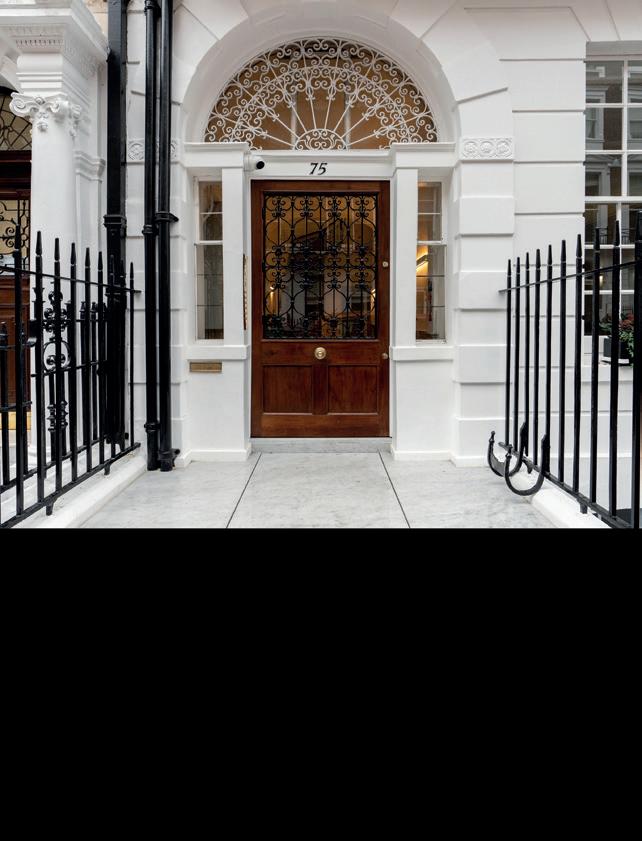

Marylebone Journal marylebonejournal.com
Marylebone Village marylebonevillage.com
Instagram: @marylebonevillage
Twitter: @MaryleboneVllge
Portman Marylebone portmanmarylebone.com
Instagram: @portmanmarylebone
Publisher LSC Publishing lscpublishing.com
Editor
Mark Riddaway mark@lscpublishing.com
Advertising sales
Donna Earrey 020 7401 2772 donna@lscpublishing.com
Contributers
Jean-Paul Aubin-Parvu
Lauren Bravo
Ellie Costigan
Clare Finney
Orlando Gili
Viel Richardson
Design and art direction Em-Project Limited mike@em-project.com
Owned and supported by The Howard de Walden Estate 23 Queen Anne Street, W1G 9DL 020 7580 3163 hdwe.co.uk annette.shiel@hdwe.co.uk
The Portman Estate 40 Portman Square, W1H 6LT 020 7563 1400 portmanestate.co.uk rebecca.eckles@portmanestate.co.uk
BROUGHT TO YOU BY THE HOWARD DE WALDEN ESTATE AND THE PORTMAN ESTATE

1 — MARYLEBONE JOURNAL / ISSUE NO. 100
MARYLEBONE JOURNAL ISSUE NO.100
HAPPENINGS 3 IN MARYLEBONE Events, exhibitions, film, music, shopping, talks, theatre and walks IN PROFILE: 10 MARYLEBONE JOURNAL Editor Mark Riddaway tells the story of the magazine’s unlikely genesis and rapid evolution A CENTENARY 14 CELEBRATION A look back at imagery and stories from the previous 99 editions of the Journal THE DIFFERENCE 33 MAKERS Julian West, head of Open Academy at the Royal Academy of Music A CLOSER 38 LOOK Food, style, home, wellbeing and healthcare Q&A: 38 VICTOR LUGGER The co-founder and CEO of Big Mamma Group on its latest restaurant: the typically spectacular Carlotta Q&A: 44 FREDDIE ELBORNE The founder of sustainable eyewear brand MONC on how his Chiltern Street store is looking to the future THE LOOK 48 Legendary designer agnès b on her new collaboration with Café du Cycliste ANATOMY OF 52 A DESIGN Mark Winstanley of The White Company on a very special line of bed linen

HAPPENINGS IN MARYLEBONE EVENTS EXHIBITIONS FILM MUSIC SHOPPING TALKS THEATRE WALKS
MUSIC
19 JUNE, 7.30 pm
SOLOMON’S KNOT AT ST JAMES’S SPANISH PLACE
St James’s Spanish Place
22 George Street W1U 3QY wigmore-hall.org.uk
Wigmore Hall transfers to a historic local church for this very special performance of Bach’s St Matthew Passion, a masterpiece of sacred music. The Solomon’s Knot collective works without a conductor or vocal scores to create an intimate and visceral interpretation.
MUSIC
23 JUNE, 10pm
LOVE, LOSS AND THE WHOLE DAMN THING: A CELEBRATION OF QUEER COMPOSERS
Wigmore Hall
36 Wigmore Street, W1U 2BP wigmore-hall.org.uk
The Fourth Choir was formed with the aim of representing the LGBT+ community on London’s classical music scene. For this Pride celebration, the group will be singing works by queer composers, from Leonard Bernstein to Jennifer Higdon.
THEATRE
UNTIL 24 JUNE
ROGER PELTZMAN: DEDICATION
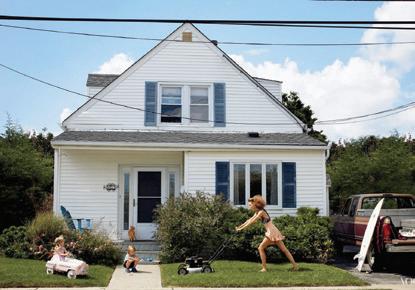
Marylebone Theatre
Rudolf Steiner House
35 Park Road, NW1 6XT marylebonetheatre.com
In this powerful one-person show, New York pianist Roger Peltzman uses performances of everything from blues to Chopin to explore his family’s tragic experiences of the Holocaust, his second-generation survivor trauma, and the respite provided by music.
MUSIC
24 JUNE, 6pm
DEBUSSY & WAGNER: MUSIC OF TRANSCENDENCE
St Marylebone Parish Church
17 Marylebone Road, NW1 5LT stmarylebone.org
As part of the St Marylebone Festival, soprano Katherine Crompton performs Wagner’s searching song cycle Wesendonck-Lieder, his serene Siegfried Idyll, and Debussy’s Prélude à l’après-midi d’un faune, conducted by St Marylebone’s director of music Bertie Baigent.
MUSIC & TALK
24 JUNE, 6.30 pm
CELEBRATE VAMVAKARIS
The Hellenic Centre
16-18 Paddington Street, W1U 5AS helleniccentre.org
Born on the island of Syros in 1905, Markos Vamvakaris was revered as the ‘patriarch of Rebetiko music’, known for his bouzouki playing and deep, earthy voice. Following a talk about his life and music, the musicians of the Rebetiko Carnival perform his greatest hits and hidden gems.
A remarkable collection of child portraits from almost 50 of the world’s greatest photographers of the past and present, including Henri Cartier Bresson, Paul Strand, Dorothea Lange, Arthur Elgort Chris Killip and Irving Penn. Many of these remarkable works are drawn from the personal collection of the gallery’s founders, Julia and Ben Burdett, who have been collecting images of children for the past 30 years. A proportion of the sale price for every print sold, ranging from 10 per cent to 100 per cent, will be donated to the Save the Children charity.
UNTIL 24 JUNE
SEEN NOT HEARD
Atlas Gallery
49 Dorset Street, W1U 7NF atlasgallery.com
3 — MARYLEBONE JOURNAL / ISSUE NO. 100 HAPPENINGS IN MARYLEBONE
1. Karlie Kloss, 2012, Atlantic Beach, by Arthur Elgort, Atlas Gallery
1. EXHIBITION
MUSIC
22 – 25 JUNE
MARYLEBONE MUSIC FESTIVAL marylebonemusicfestival.com
A four-day programme of performances in Manchester Square Gardens. Highlights include The Orion Symphony Orchestra performing cinematic works by Hans Zimmer and John Williams, Sue Perkins conducting Peter and the Wolf, an appearance by The Royal Band of The Welsh Guards, and a special performance of Mozart’s Mass.
TALK
27 JUNE, 7pm
KATHRYN SCANLAN Daunt Books

83-84 Marylebone High Street, W1U 4QW dauntbooks.co.uk
Based on transcribed interviews with Sonia, a horse trainer, Kathryn Scanlan’s Kick The Latch is a remarkable novel that vividly captures the arc of one woman’s life at the racetrack. The author will be interviewed by the journalist and novelist Megan Nolan.
MUSIC
26, 27 & 29 JUNE
SEEN AND HEARD FESTIVAL Royal Academy of Music
Marylebone Road, NW1 5HT ram.ac.uk
Returning for its third year, this series of concerts celebrates diversity in classical music. Students from different departments unite to perform old and new music by underrepresented composers, including Sanae Kanda, Yoshi Weinberg and Adolphus Hailstork.
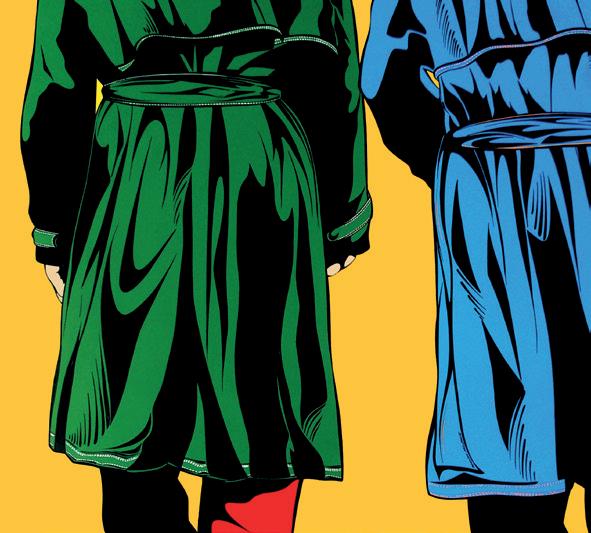
4 — MARYLEBONE JOURNAL / ISSUE NO. 100 HAPPENINGS IN MARYLEBONE
1.
2.
MUSIC
4 JULY, 1pm, 5 pm & 7.30 pm
THE CARDINALL’S MUSICK: BYRD MASSES
Wigmore Hall
36 Wigmore Street, W1U 2BP wigmore-hall.org.uk
The perilous situation of Catholics in Elizabethan England meant that William Byrd’s three Masses had to be sung in secret in the homes of believers. They are performed here by The Cardinall’s Musick vocal ensemble to mark the 400th anniversary of his death.
EXHIBITION
For 39 years, London-based artist Deborah Azzopardi has been creating bold, bright, joyful pop art images. Presented by the Cynthia Corbett Gallery, the most obvious point of comparison for this much-anticipated solo exhibition is the work of Roy Lichtenstein, but the artist’s perspective, in the form of both her subject matter and her style, is unequivocally feminine.
26 JUNE – 1 JULY
DEBORAH AZZOPARDI: ASPECTS OF GLAMOUR

67 York Street
67a York Street, W1H 1QB 67yorkstreet.com
3.
This feminist musical romp set in the 1850s begins in a rural pub in the Forest of Dean.

Flora is following a battalion squad headed for the Crimea. Runaway Maud is looking for her mother. The two women share a pint, fall in love, but after a brutal attack are forced to flee to London.
8 – 9 JULY A SOLDIER’S WOMAN The Cockpit Gateforth Street, NW8 8EH thecockpit.org.uk
MUSIC
7 JULY, 1pm
RYAN BANCROFT CONDUCTS THE ACADEMY SYMPHONY ORCHESTRA
Royal Academy of Music Marylebone Road, NW1 5HT ram.ac.uk
Ryan Bancroft, principal conductor of the BBC National Orchestra of Wales, makes his debut with the Academy Symphony Orchestra in a programme featuring Stravinsky’s ballet Petrushka and Gershwin’s An American in Paris.
THEATRE
8 JULY, 5PM
MANSFIELD PARK
St Marylebone Parish Church
17 Marylebone Road, NW1 5LT stmarylebone.org
For the St Marylebone Festival, the Waterperry Opera Festival’s acclaimed production of Jonathan Dove’s Mansfield Park – based on Jane Austen’s classic story of an impoverished young girl sent to live with her wealthy aunt and uncle – works its magic in the atmospheric setting of St Marylebone Parish Church.
THEATRE
6 – 9 JULY
CAROUSEL

Royal Academy of Music
Marylebone Road, NW1 5HT ram.ac.uk
The Academy’s Musical Theatre Company presents Rogers & Hammerstein’s Carousel. In a Maine coastal village towards the end of the 19th century, carefree carnival barker Billy Bigelow is coerced into committing a robbery to support his pregnant wife, Julie Jordan, after losing his job.
5 — MARYLEBONE JOURNAL / ISSUE NO. 100
1. Mayfair Trenchcoats, by Deborah Azzopardi, 67 York Street
2. Kick the Latch, by Kathryn Scanlan, Daunt Books
3. Mansfield Park, St Marylebone Parish Church
4. A Soldier’s Woman, The Cockpit IN
HAPPENINGS
MARYLEBONE
THEATRE
4.
THEATRE
UNTIL 12 JULY
JULIUS CAESAR
Marylebone Theatre
Rudolf Steiner House
35 Park Road, NW1 6XT marylebonetheatre.com
The Factory theatre company turns the rooms and corridors of Steiner House into the courtyards and catacombs of Ancient Rome for this freewheeling promenade performance of Shakespeare’s classic tale of civil strife and political murder.
MUSIC
10 – 14 JULY, 7.30 pm
MOZART WITH MAO FUJITA
Wigmore Hall
36 Wigmore Street, W1U 2BP wigmore-hall.org.uk
The young Japanese pianist Mao Fujita released his complete recording of the Mozart sonatas in 2022. Here, he performs three of those sonatas together with two inimitable individual movements – the Rondo (1787) and Adagio (1788) – and the 1782 variations on the tune now best known as Twinkle, Twinkle, Little Star!

EXHIBITION
UNTIL 15 JULY
THE BROWN COLLECTION
The Brown Collection
1 Bentinck Mews, W1U 2AF glenn-brown.co.uk
This eponymous exhibition at The Brown Collection shows off the full span of Glenn Brown’s body of work, including his earlier paintings, drawings, sculptures, editions, and three new works from 2022: Bikini; Shipwreck, Custom of the Sea; and We’ll Keep On Dancing Till We Pay the Rent.
MUSIC
16 JULY, 7.30pm
GOLDA SCHULTZ: THIS BE HER VERSE
Wigmore Hall
36 Wigmore Street, W1U 2BP wigmore-hall.org.uk
A programme of songs by women composers of the past 200 years, performed by South African soprano Golda Schultz, accompanied by pianist Jonathan Ware. Includes works by Clara Schumann, Nadia Boulanger, Rebecca Clarke and Kathleen Tagg.
THEATRE
17 JUNE – 22 JULY

ROBIN HOOD
Regent’s Park Open Air Theatre

Regent’s Park, NW1 4NU openairtheatre.com
A new take on the classic tale, set in a desperate, divided kingdom where only the truly cunning can outwit the sheriff’s terrifying wrath. An epic tale told with stirring songs and absolutely no green tights, playwright Carl Grose’s Robin Hood is a riotous folk tale for our desperate, divided times.
6 — MARYLEBONE JOURNAL / ISSUE NO. 100 HAPPENINGS IN MARYLEBONE
1.
2.
3.
EVENT
In the middle of the summer, Portman Square Garden is being opened up for six days for an event that offers the opportunity to spend time in one of the area’s most beautiful settings. The event, run by the Baker Street Quarter Partnership, will feature street food stalls, a bar provided by Philglas & Swiggot, a full programme of wellbeing activities, a big screen showing the tennis action at Wimbledon, plus a brand new guest kitchen in which a rotating cast of local restaurants will showcase their offering.
11 – 16 JULY
SUMMER IN THE SQUARE
Baker Street Quarter Partnership bakerstreetq.co.uk
THEATRE
30 JUNE – 22 JULY
THE TEMPEST
Regent’s Park Open Air Theatre Regent’s Park, NW1 4NU openairtheatre.com
When the sorcerer Prospero conjures up a storm to shipwreck his enemies, he sets the scene for an enchanting tale of spells, monsters, revenge and romance. This 75-minute daytime show brings Shakespeare’s text thrillingly to life for younger audiences aged six and over.
EXHIBITION
UNTIL 28 JULY
CHIARA AMBROSIO: MONOCHORDS
The Hellenic Centre
16-18 Paddington Street, W1U 5AS helleniccentre.org
Chiara Ambrosio presents a suite of linocuts inspired by Yannis Ritsos’s Monochords, a collection of 336 one-line poems composed by the Greek poet in August 1979 following one of his many political exiles on the island of Samos.
EXHIBITION
UNTIL 5 AUGUST CITIES OF THE NIGHT RIBA
66 Portland Place, W1B 1AD architecture.com
Presented in collaboration with the Royal College of Art, this multi-media exhibition brings together three artists – Blees Luxemburg, Alisa Oleva, and Chooc Ly Tan – who explore the potential of the urban night-time via large-scale photography, a global video archive and a DJ set.
EXHIBITION
27 JUNE – 12 AUGUST
BRYAN ADAMS IN COLOUR
Atlas Gallery
49 Dorset Street, W1U 7NF atlasgallery.com
A premiere of new work by Canadian photographer and musician Bryan Adams. Inspired by the expression “through rosetinted glasses”, the exhibition presents some of his striking celebrity portraits, of everyone from Mick Jagger to the Queen, set behind the dreamlike filter of coloured plexiglass.

THEATRE
6 AUGUST, 6.30pm
THE BARBER OF SEVILLE
The Nannies Lawn Regent’s Park, NW1 4NU operabrava.com
Opera Brava, a touring opera company that specialises in outdoor performances, brings Rossini’s comic masterpiece to Regent’s Park. Figaro, the titular barber, assists Count Almaviva in wooing the beautiful Rosina away from her lecherous guardian, Dr Bartolo. Frivolity and timeless melodies abound.

EXHIBITION
UNTIL 12 AUGUST
THE ARCHITECT HAS LEFT THE BUILDING RIBA
66 Portland Place, W1B 1AD architecture.com
This dual-screen film installation weaves together moments of joy and intimacy from the archives of photographer and filmmaker Jim Stephenson. Through a series of cinematic vignettes, it subtly documents the ways that people use architecture when left to their own devices.

7 — MARYLEBONE JOURNAL / ISSUE NO. 100
HAPPENINGS IN MARYLEBONE
6.
1. Summer in the Square, Portman Square Garden
2. Julius Caesar, Marylebone Theatre
3. Mao Fujita, Wigmore Hall
4. Golda Schultz, Wigmore Hall
5. Amy Winehouse, Spinning Records, London 2010, by Bryan Adams, Atlas Gallery
6. The Architect Has Left the Building, RIBA
4.
5.
FILM
FROM 25 AUGUST
SCRAPPER
Regent Street Cinema
307 Regent Street, W1B 2HW regentstreetcinema.com
Charlotte Regan’s Sundancewinning debut feature tells the story of Georgie, a 12-year-old girl who lives on her own in London, living on the proceeds of stolen bikes. Then her estranged father shows up out of the blue, disturbing the world she’s constructed for herself in the absence of adults.

THEATRE
1 – 27 AUGUST
THE CAMDEN FRINGE 2023
The Cockpit Gateforth Street, NW8 8EH thecockpit.org.uk
The Camden Fringe offers performers from a wide range of disciplines, including drama, comedy, dance and poetry, the chance to present new material in a festival setting, without the time and money needed to take a show to Edinburgh. The Cockpit will, as always, be one of the main venues for the festival.
MUSIC
7 SEPTEMBER, 7.30pm
SIR STEPHEN HOUGH
Wigmore Hall
36 Wigmore Street, W1U 2BP wigmore-hall.org.uk
Much-loved musician and composer Sir Stephen Hough opens the new Wigmore Hall season with a characteristically varied programme, beginning with music by Federico Mompou, a Catalan composer he has championed, and including Partita, one of Sir Stephen’s own works for piano.
THEATRE
29 JULY – 16 SEPTEMBER
LA CAGE AUX FOLLES
Regent’s Park Open Air Theatre
Regent’s Park, NW1 4NU openairtheatre.com
This glorious musical revival of Jerry Herman and Harvey Fierstein’s show-stopping classic tells the fraught story of Georges, who MCs at a St Tropez drag nightclub, his husband Albin, his son Jean-Michel, and Jean-Michel’s fiancée Anne, the daughter of a deeply homophobic politician.
FOOD
One of the fleeting treats of a Marylebone summer is the availability through the warmer months of Orrery’s beautiful rooftop terrace. Offering a place of sanctuary high above the high street, the terrace is open for dining until the end of September. The space is lined with lavender and olive trees, offering the sense (and scents) of a Provençal garden – an association enhanced through a collaboration with Maison Mirabeau, makers of exceptional Provence rosé.

UNTIL END OF SEPTEMBER ORRERY TERRACE
55 Marylebone High Street, W1U 5RB orrery-restaurant.co.uk
MUSIC
17 JUNE – 17 SEPTEMBER
REGENT’S PARK MUSIC FESTIVAL
regentsparkmusicfestival.org.uk
Throughout the summer, the Regent’s Park Band Stand will be hosting a series of free outdoor concerts every Sunday (12-5pm). The programme also includes Saturday performances at the Broadwalk (2-4pm). The diverse line-up features 45 different groups, including brass bands, concert bands, jazz bands and choirs.
EXHIBITION
UNTIL 15 OCTOBER
PORTRAITS OF DOGS: FROM GAINSBOROUGH TO HOCKNEY
The Wallace Collection
Manchester Square, W1U 3BN wallacecollection.org
Bringing together over 50 works of art, including paintings, sculptures, drawings and even taxidermy, this exhibition highlights the unique bond between humans and their canine companions across many centuries, showing dogs in all their different shapes and sizes.
8 — MARYLEBONE JOURNAL / ISSUE NO. 100
1. Scrapper, Regent Street Cinema
HAPPENINGS IN MARYLEBONE
2. Orrery Terrace, Orrery
1.
2.
IN PROFILE MARYLEBONE JOURNAL
The Marylebone Journal’s
Words: Mark Riddaway
Portrait: Orlando Gili
10 — MARYLEBONE JOURNAL / ISSUE NO. 100
editor tells the story of the magazine’s unlikely genesis, rapid evolution and career-shaping impact
MARK RIDDAWAY IN PROFILE: MARYLEBONE JOURNAL

11 — MARYLEBONE JOURNAL / ISSUE NO. 100 IN PROFILE: MARYLEBONE JOURNAL >
It was with the plop of a letter onto my doormat that my life completely changed. In my mind’s eye, this missive was written by quill on a scroll of parchment. In reality, I think it was probably printed on normal paper. But definitely very posh paper, the thick, creamy-coloured kind, with an ornate crest at the top. The letter told me in suitably formal language that The Howard de Walden Estate, an institution of which I was entirely ignorant, was inviting me to apply to become the editor of a new magazine.
This was, it has to be said, something of a turn-up for the books. It was summer 2004, I was just about to turn 30, and I’d wasted most of the previous decade in a telecoms project management job that bored me to tears. I really wanted to be a writer, but after leaving university I’d had neither the personal initiative nor the industry connections to take either of the two usual routes into journalism: the hard grind of article pitching and unpaid internships or the frictionless slide of blatant nepotism.
Now, though, I was giving it a proper go. I’d left my job and, after completing a six-month journalism diploma at a college in Bayswater, I’d begun scratching around in search of freelance writing work. With very little success. I may be a decent writer, but I’m terrible at putting myself out there, at hassling strangers for commissions. As a result, I found myself on the verge of defeat, increasingly resigned to returning to my previous line of work which, while unfulfilling, at least paid my rent. Then that sudden snap of the letterbox and the game was on.
Howard de Walden was, I read after googling the name, one of the historic landowners of Marylebone. The company had over the previous few years embarked on a mission to boost the area’s appeal by reviving its rather moribund high street, a stretch previously dominated by charity shops and pockmarked with empty units. Two large but classy retailers, Waitrose and The Conran Shop, had been persuaded to anchor the new-look street. A host of highly regarded independent shops such as Daunt Books and La Fromagerie had followed in their wake after being tapped up by polite men and women in suits offering generous terms and a compelling vision.
To help promote the area’s increasingly vibrant retail and cultural landscape, Howard de Walden’s CEO, Andrew Ashenden, and newly appointed creative director, Jenny Hancock, had decided that what Marylebone needed was a local magazine. There had been a version of the Journal in circulation for a few years, produced by a local resident, but she’d moved away and they were looking to create something new and more explicitly professional. In keeping with the business’s enlightened preference for small-scale specialists over corporate giants, they chose not to approach an established publishing company and instead asked my journalism college for a list of graduates who might be up
to the job of building something lasting from the ground up. My name was one of those put forward.
After sending an application, I was invited to Howard de Walden’s Queen Anne Street offices, which back then retained something of a period-drama vibe: a warren of rooms filled with dark wood and old paintings, and proper tea trays with proper tartan tea cosies delivered by a proper tea lady. In an imposing old board room, sipping from china cups (with saucers), Andrew and Jenny listened carefully to my pitch. I may not have known much about making magazines, but from a few months of freelancing I did know a tiny bit more than the two people who were interviewing me – enough, I hoped, to be vaguely plausible.
And so it came to pass. To my delight and bemusement, the next formally worded letter I received contained a contract to produce four magazines a year (soon to be six), 15,000 copies per issue. The venture would be largely funded by Howard de Walden and topped up by advertising sales. That was my first job in journalism: CEO, editor, sub-editor, writer, proof-reader, salesperson, delivery driver and general dogsbody of a magazine publishing company. With retrospect, it’s lucky that utter ignorance provides such sturdy armour. If I’d even begun to suspect just how little I knew, I’d have thrown up on my shoes.
Issue one of the Marylebone Journal came out just over 18 years ago, in the spring of 2005. Looking at it now, as a seasoned professional, brings no end of horrors. But even while wincing at the naivety, I can appreciate its raw charm. Structurally and visually it’s all a bit of a mess, but the ideas are there and the writing isn’t terrible. The cover is a close-up picture of an egg, representing spring, but it looks more like a close-up shot of the freckled head of a bald man. A bewildering choice. The second issue was a bit better, sufficiently so that no one tried to shut the operation down.
I was an extremely lucky man, in two ways. Firstly, that Jenny was fully committed to the ride, bursting with ideas and enthusiasm and – as a resident of the area – tuned in to absolutely everyone and everything that mattered. Secondly, that Marylebone is a magnet for proper writers. It wasn’t long before emails and calls started arriving from local freelancers who liked the idea of contributing to a community publication. There was an expert in architecture, an art historian, an awardwinning food writer, a former Fleet Street fashion editor, a book reviewer. One frequent early contributor was a history writer obsessed with Victorian and Edwardian scandals featuring feckless aristocrats, pervy bishops and mysterious corpses, who I presumed for ages was a local resident before discovering that he was a retired talk radio host in Atlanta, Georgia. I still had to do a lot of the writing, though. I even established a female pseudonym
12 — MARYLEBONE JOURNAL / ISSUE NO. 100 IN PROFILE: MARYLEBONE JOURNAL
BACK TO THE START
April 2005 was a very different time. Tony Blair was prime minister, the British economy was booming, Arsenal were champions, and Peter Kay’s version of (Is This the Way To) Amarillo? was somehow sustaining a seven-week stint at number one. The content of the first issue of the newly launched Marylebone Journal, though, seems highly familiar: the same celebration of culture, food, style and place that continues to this day.
After the deluge
The high commissioner for the Maldives on the impact of the 2004 Indian Ocean tsunami
Market economy
A review of the societal factors driving the rise of the Marylebone farmers’ market
Family affairs
Profiles of three multi-generation businesses: Paul Rothe & Son, James Taylor & Son, and Bramah
Security Equipment
A novel approach
Acclaimed American author Jill Robinson on her Wimpole Writers Workshop
Revolution, betrayal & death
The dramatic story of the Cato Street conspiracy
Chef’s special
A recipe for oven-roast foie gras and hazelnuts from Andre Garrett of Orrery
Spring cleaning
Seasonal beauty products from Space NK and Fresh
Sick & tired
The exhausting world of sleep disorders
Perfect pitch
The architectural renewal of the Royal Academy of Music
Local lives
The thoughts of local resident Clare Bornholt
Marylebone’s greatest residents
A profile of the 18th century geologist Charles Lyell
Marylebone in literature

An extract from Lord Arthur Saville’s Crime by Oscar Wilde
Crossword
Mark’s wildly ambitious first attempt at writing a crossword
– Martine Roberts – to write articles about makeup and dresses. But now I wasn’t alone.
Securing the advertising needed to make it all viable was hard. Jenny managed to emotionally blackmail
Waitrose into taking the back cover for the first couple of years, which was a great start, but selling was not my strong point and I didn’t have the funds at first to hire anyone full time. I was assisted massively by Steve – a graphic designer who worked alongside me for the first few years and gave me a desk in his cramped but characterful studio just off Trafalgar Square. Our inept attempts at sales were fortified by a rolling cast of misfits working on commission in a windowless room at the back of the building (a cupboard, in essence). There was a charming but slightly rootless marine, just back from Afghanistan. Then the glum younger brother of a very famous eighties pop star. Then a rakish, silver-tongued veteran who couldn’t quite disguise the fact that his breakfast Lucozade was about 50 per cent vodka.
It was only after a pocket-sized dynamo called Donna Earrey essentially bullied me into giving her a salaried sales role that the business really began to stabilise. At the same time, two of the Journal’s most enthusiastic freelance contributors, Viel Richardson and Jean-Paul Aubin-Parvu, abandoned their jobs as chorizo-sandwich sellers at Borough Market and joined me as full-time writers. Then Clare Finney, whose mum lived in Marylebone, came to do work experience while studying for a journalism masters and never quite managed to leave.
Suddenly, we had a proper publishing company on our hands. As our speed, competence and revenues increased, we were able to take on other projects, other clients, other magazines, covering everything from food to weather to parenting. We moved into a small, dusty office of our own, then into a big, light, airy office in a converted factory building. After Jean-Paul left to commit more time to being a musician, we were joined by a subeditor, Ellie Costigan, who immediately reduced the flow of sloppy editing mistakes by about 80 per cent. Mike Turner, a brilliant graphic designer who’d started working on projects for Howard de Walden, became our art director and moved us up several levels. That was the team for years on end. We turned out dozens of magazines, won loads of awards and became friends for life.
Throughout that entire journey, the Journal was the absolute cornerstone of our business. It was also a source of consistent pleasure. For magazine people like us, it’s a complete gift: it’s hard to go wrong with a publication that can feature Wigmore Hall, The Wallace Collection, the Royal Academy of Music, embassies, cultural institutions, a dozen specialist galleries, Daunt Books, the Harley Street
13 — MARYLEBONE JOURNAL / ISSUE NO. 100 IN PROFILE: MARYLEBONE JOURNAL
>
Medical Area, a whole slew of amazing restaurants and bars, a burgeoning independent retail community, and a residential population that includes a disproportionate number of actors, writers, fashion designers and brilliant eccentrics. At the drop of a hat, we can interview fascinating, charismatic individuals with expertise to share and stories to tell. We’ve been able to visit some amazing places, from the utopian factories of Sunspel and David Mellor to the eponymous Sicilian birthplace of Ortigia, to the Basque Country food culture that inspired Lurra. People would often ask how we found enough ideas to fill 100-or-so pages six times a year. In truth, we had the opposite problem: the awkwardness of saying no to pitches or sitting on ideas for months on end because there simply wasn’t enough space to fit everything in.
This problem was exacerbated when The Portman Estate decided to join the party. Sitting directly to the west of The Howard de Walden Estate and similarly drenched in history, The Portman Estate is Marylebone’s other great landlord, and one with an equally progressive, long-termist approach to its community. For years, Portman had been commissioning its own magazine, which – while perfectly adequate – clearly wasn’t a patch on the Journal. In 2016, in the local magazine equivalent of the fall of the Berlin Wall, the two great estates came together to start jointly funding and overseeing the magazine. The magazine became even greater than the sum of its parts. The Marylebone Journal was now truly the Marylebone Journal.
The past few years have seen another significant change. Driven partly by Covid and partly by the fact that change is good, I closed our little publishing company in 2021 and we all went our separate ways. Viel and Ellie are now both magazine editors in their own right. Clare is one of the country’s top food writers – her brilliant new book, Hungry Heart, came out a few weeks ago. I provide consultancy to various clients, I’ve written one book about food history (Edible Histories, available from all good bookshops!) and I’ve started researching the next. Five times a year, though, we all still come together for the Journal.
The magazine has a sharp new design and a slightly tighter focus than its previous, more expansive incarnation, but the character is otherwise unchanged. Most importantly, it still has the unwavering support of the two estates – a remarkable level of commitment. Annette at Howard de Walden and Rebecca and Kate at Portman provide ideas and direction, but they give us the space to make it all work.
I’m now 18 years and 100 issues in. I’m still being paid to write and edit: a prospect that seemed ludicrously implausible until that sudden snap of my letterbox.
Today, looking back at it all, I have just one regret: I didn’t keep that life-changing letter.
A CENTENARY CELEBRATION THE PEOPLE
Interviews with local characters have always provided the beating heart of the Journal. To kick off a retrospective of 100 issues of the magazine, here are some of the very best portraits taken by our brilliant photographers to accompany those pieces
IN PROFILE: MARYLEBONE JOURNAL 14 — MARYLEBONE JOURNAL / ISSUE NO. 100
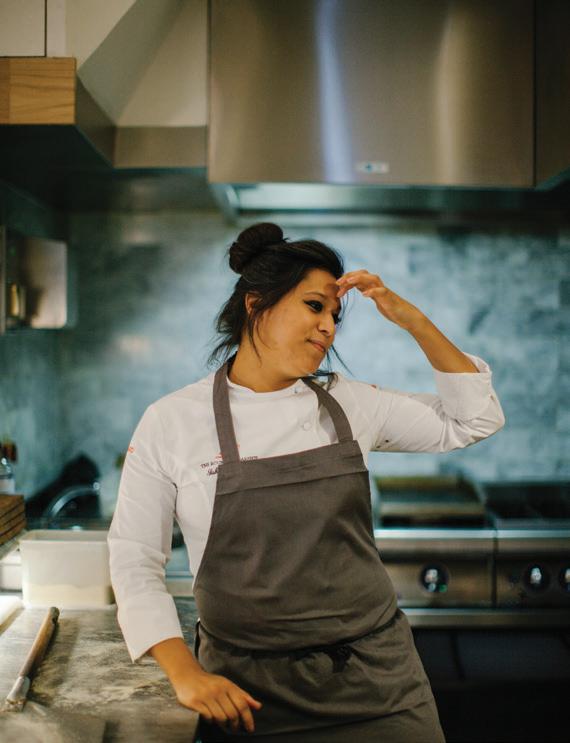
> 15 — MARYLEBONE JOURNAL / ISSUE NO. 100 A CENTENARY CELEBRATION: THE PEOPLE
Chef Sabrina Gidda, who ran the kitchen at Bernardi’s (now renamed The Italian Greyhound).
Image: Joseph Fox
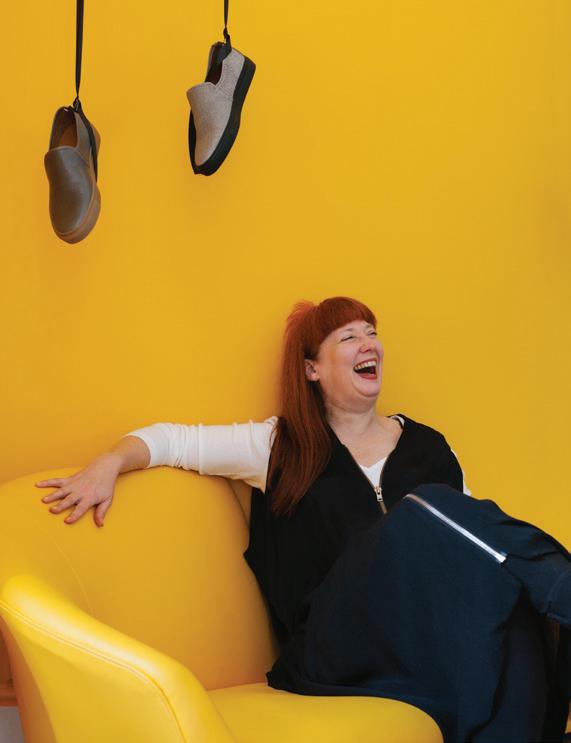
16 — MARYLEBONE JOURNAL / ISSUE NO. 100 A CENTENARY CELEBRATION: THE PEOPLE
“Originally, I wanted to have cocktails and shoes – people coming in, the shoes flying around, everything so dynamic! – but licensing proved to be an issue.”
Tracey Neuls
HOW THINGS CHANGE THE PRINT PROCESS
Issue 1
To get the magazine printed in 2005, we had to burn all the artwork files and individual images onto DVDs, then go to a Post Office to send them to the printer. A couple of days later, we received an envelope of printed proofs. If we wanted to make small text changes, we’d call the printer and they’d do it for us. Anything more substantial, we’d have to burn a new DVD and head back to the Post Office.
Total time: 3-5 days.
Issue 100
This issue’s process: Make PDF. Upload PDF. Check proofs online. Upload corrected pages. Job done.
Total time: 1-2 hours.
Opposite: Shoe designer Tracey Neuls, owner of the eponymous Marylebone Lane store.
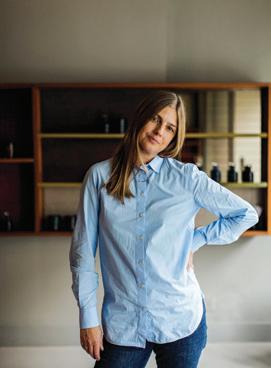
Image: Joseph Fox
Right: Lyn Harris, owner of Perfumer H.
Image: Orlando Gili
Below right: Ollie Templeton, one of the co-founders of the groundbreaking Carousel restaurant.

Image: Joseph Fox
Below left: John Gilhooly, artistic and executive director of Wigmore Hall.
Image: Orlando Gili

17 — MARYLEBONE JOURNAL / ISSUE NO. 100 > A CENTENARY CELEBRATION: THE PEOPLE

18 — MARYLEBONE JOURNAL / ISSUE NO. 100 A CENTENARY CELEBRATION: THE PEOPLE
This page: Paul de Zwaart, owner of furniture company Another Country. Image: Joseph Fox
“We don’t design for design’s sake. Young designers need to express themselves, explore new materials and techniques. But we don’t operate that way.”
Paul de Zwaart
Opposite: Tony Hassan of the David Penton & Son hardware shop.
Image: Orlando Gili
STAR POWER
The Journal has always had a sharp focus on local matters, but that hasn’t prevented us from interviewing figures of national or international standing who just happen to have had a Marylebone connection. Here’s a selection of our starriest subjects.
Agnès b
Stuart Broad
Sebastian Faulks
Sir Karl Jenkins
Howard Jacobson
Fay Maschler
Roland Mouret
Michael Parkinson
Jay Rayner
Michael Rosen
Zandra Rhodes
Michel Roux Jr
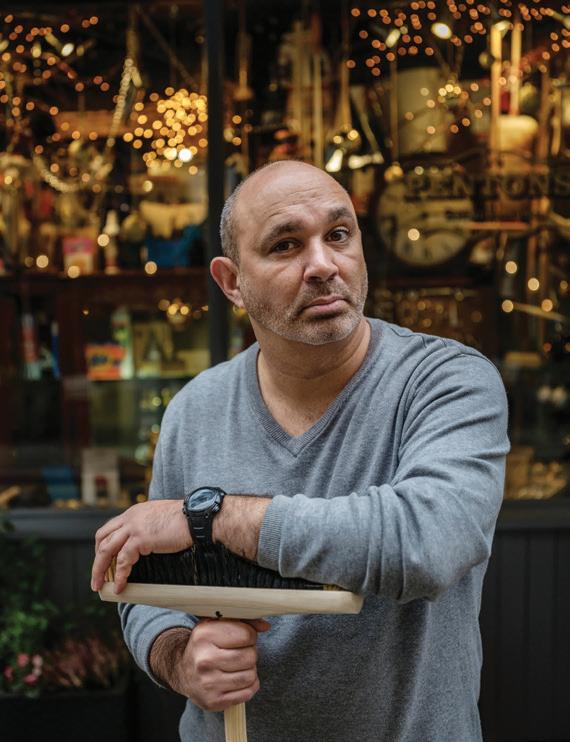
Jennifer Saunders (below)

Rick Wakeman
Olivia Williams
Barbara Windsor
19 — MARYLEBONE JOURNAL / ISSUE NO. 100 A CENTENARY CELEBRATION: THE PEOPLE
>
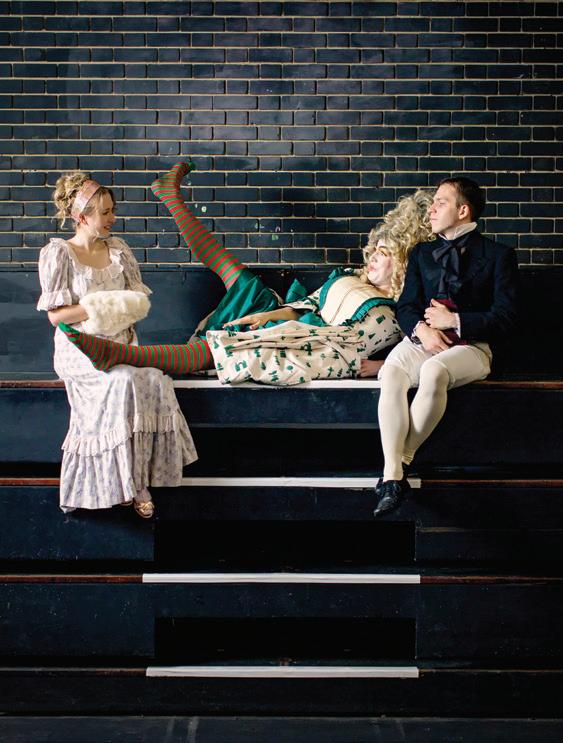
20 — MARYLEBONE JOURNAL / ISSUE NO. 100 A CENTENARY CELEBRATION: THE PEOPLE
“People are quick to slag it off, but panto is the most popular form of political satire. It is simply the best way to critique what has happened and mock people in authority.”
By Jove Theatre Company
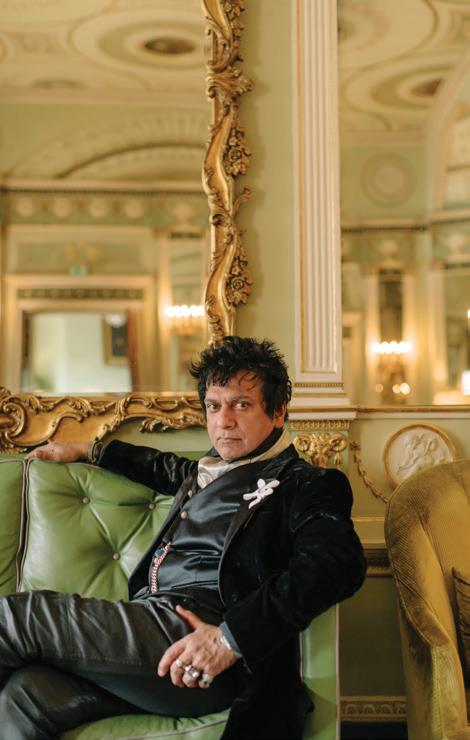
21 — MARYLEBONE JOURNAL / ISSUE NO. 100
>
“tbc.”
Opposite: Members of the By Jove Theatre Company, performers of panto at The Cockpit theatre.
Image: Orlando Gili
Right: Robin Dutt, writer, dandy and impassioned evangelist for the Home House members’ club.
Image: Orlando Gili
“Chris Eubank gave me a spin around Portman Square in his juggernaut, tooting all the way. I mean, really, you could have heard it in Tooting.”
Robin Dutt
“I was dying. The sister said: ‘You’re doing one of your silly experiments aren’t you? I’ll give you some adrenaline.’ She put 0.3cc of adrenaline in my arm. After that, I felt marvellous”
Dr Bill Frankland
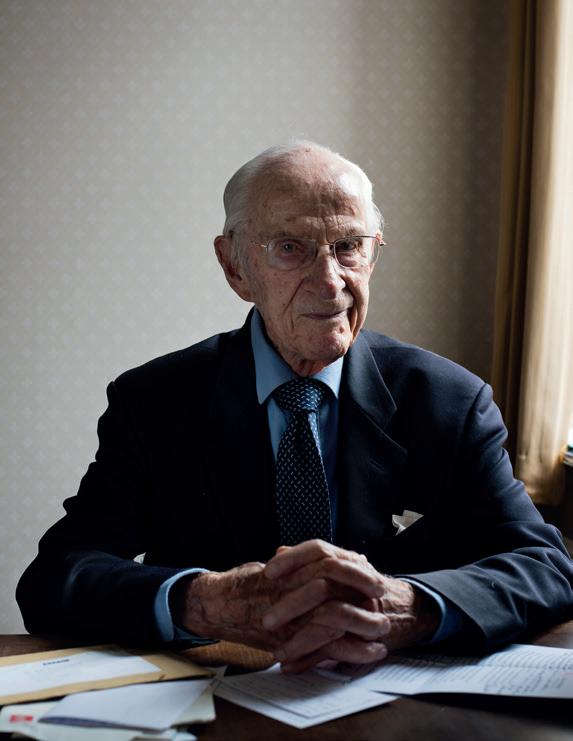
A CENTENARY CELEBRATION: THE PEOPLE
22 — MARYLEBONE JOURNAL / ISSUE NO. 100
Dr Bill Frankland, a pioneer in the field of allergies, survivor of a Japanese internment camp and former doctor to Saddam Hussein.
Image: Alice Mann
It would be impossible to produce the Journal without the support of local advertisers. Dozens of them have played their part over the years, but there are four businesses that supported us in issue 1 and are still continuing to do so today, to their eternal credit.
Carter Jonas
Cologne & Cotton
Jeremy James McGlashans
A CENTENARY CELEBRATION
THE FAB FOUR
23 — MARYLEBONE JOURNAL / ISSUE NO. 100 >
THE PLACES
Creating our long-form features has given our writers and photographers access to some amazing locations and activities. Here are some of the most memorable

“There’s a real sense of belonging. That’s the beauty of independent wrestling. People always say that wrestling’s fake, but it’s more real than you’d ever think.”

24 — MARYLEBONE JOURNAL / ISSUE NO. 100 A CENTENARY CELEBRATION: THE PLACES
Andy Quildan, wrestling promoter
This page: We spent a happy afternoon with the regulars at a Matinée Classics screening at Regent Street Cinema, which offers subsidised films and dancing for over-55s.
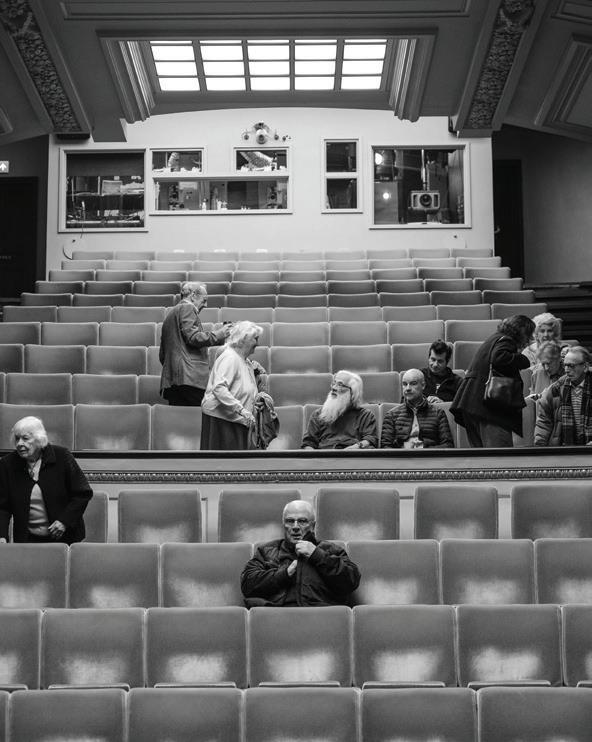
Image: Orlando Gili
Opposite: We went behind the scenes to interview the wrestlers and hyped-up fans of Revolution Pro Wrestling.
Image: Orlando Gili
25 — MARYLEBONE JOURNAL / ISSUE NO. 100 A CENTENARY CELEBRATION: THE PLACES
“I love the films, the music and the dancing. I love this beautiful cinema, the ambience and the people. I get a joy from everyone.”
>
Cindy Dawkins-Lloyd, Matinée Classics regular

26 — MARYLEBONE JOURNAL / ISSUE NO. 100 A CENTENARY CELEBRATION: THE PLACES
“The main skill you’re employing is the ability to read a script. After that, you have to be able to cope with the untoward and react to circumstances.”
Neil Paknadel-Glensman, deputy superintendent registrar
For a very memorable feature,
SKILL LIST
For several years, one of the main tropes of the magazine was a feature in which one of us – usually Jean-Paul – would spend a day learning a new skill from a local expert, with hilarity often ensuing. We now have skillsets that are both incredibly broad and pointlessly shallow. Here are a few of our questionable talents:

Ballet
Ballroom dancing
Butchery
Cake decorating
Chess
Egg cooking
Fencing
Flower arranging

Hairdressing
Indaba yoga
Jewellery making
Jitterbugging
Ju jitsu
Long-distance running
Ravioli making
Singing
Super-car driving
Volga Russian dancing
Zookeeping
27 — MARYLEBONE JOURNAL / ISSUE NO. 100 A CENTENARY CELEBRATION: THE PLACES
we were given behind-the-scenes access to the Old Marylebone Town Hall, one of London’s most famous civil wedding venues.
>
Image: Christopher L Proctor
Left: A day reporting on the music and madness of the Marylebone station public piano.

Image: Joseph Fox
Below left: A visit to the Sunspel factory in Nottinghamshire.
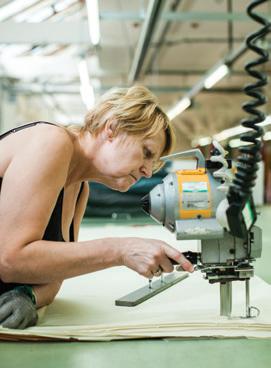
Image: Joseph Fox
Opposite: Street photography of passing strangers being asked to try on hats by local miliner Sahar Freemantle.
Image: Orlando Gili
COMPETITION AUTHORITY
The opportunities to cover sport in the Journal have been limited (we’ve done a bit with Lord’s, based on the fact that the MCC is the Marylebone Cricket Club, but that was always a bit of a reach). We have, though, managed to find some pleasingly obscure competitions to report on.
UK Scrabble Championship
In 2007, the final of the UK Scrabble Championship was held at the Cavendish Conference Centre in Duchess Mews. We were there for its tense denouement as 57-year-old former weightlifter Jake Jacobs eventually triumphed over Christian Brown, a 32-year-old civil servant. In an epic deciding leg, Jake’s winning words included SOLUTIVE (a laxative) and VUGS (rock cavities). He’d missed the previous two tournaments after a heart attack. Stressful business, Scrabble.
UK Sommelier of the Year
In 2008, we had our minds blown at the final of the UK Sommelier of the Year contest, in which the head sommeliers of The Fat Duck, Tom Aikens and the Hotel du Vin group faced off in a packed Royal Society of Medicine auditorium. After several rounds of complex role plays and fiendish blind tastings, the competition decider involved them pouring a complete magnum of champagne as evenly as possible into 16 glasses, with no topping-up allowed. Fiendish stuff.
I Primi d’Italia
In 2016, we accompanied Martin Major, head chef at L’Autre Pied, to the famous pasta festival in the historic Italian town of Foligno, where he was competing head-to-head with a local chef in a wildly ambitious attempt to demonstrate that a British cook can make pasta better than an Umbrian native. After maybe supping a little too much wine in all the excitement, Martin sliced the end off his finger, before recovering his poise to achieve the best possible result: losing, but not too badly.
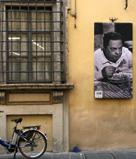
28 — MARYLEBONE JOURNAL / ISSUE NO. 100 A CENTENARY CELEBRATION: THE PLACES
“If my Adelina could turn the piano around so she was facing her audience, she would. She loves the attention.”
Caroline, mother of two-yearold Adelina, a regular on the Marylebone station piano

29 — MARYLEBONE JOURNAL / ISSUE NO. 100 > A CENTENARY CELEBRATION: THE PLACES
Journal and subsisted on a diet of Jacob’s Creek, fishfingers and the yellow stickered items that lurk in Sainsbury’s on a Sunday. I didn’t have £250 in my bank account, let alone £250 to spend on a cashmere jumper.
MJ MEMORIES
BLAST FROM THE PAST
Mark
Riddaway Editor, from 2005
For the third issue of the Journal, our history feature told the story of Stephen Ward, the Marylebone osteopath who was cast as one of the sacrificial lambs of the Profumo affair in the 1960s, a naïve man destroyed by forces beyond his control as the political establishment closed ranks. To accompany the piece, I wanted to use the famous photo of Christine Keeler, the woman at the heart of the scandal, sitting naked astride a chair in Lewis Morley’s photography studio. It took me a while to find a contact number (a fax, which really dates this story) to ask about licensing. A couple of days after faxing my request, I got a call – from Christine Keeler (or Sloane, as she was now known).

Unlike so many women whose famous faces have been exploited through the ages for other people’s profit, Christine had managed to secure the rights to Morley’s photo in lieu of payment for the shoot, meaning she controlled who could use it and at what cost. She wanted to know more about me and about the magazine. I asked her about her memories of Marylebone but didn’t pick at the old scars of the scandal, which I think she appreciated. At the end of the call, a little bit charmed, I think, she said: “Don’t use the picture that everyone uses. I’ll send you the whole set.”
After I’d sent a cheque (another icon from the past), an envelope arrived containing six large prints, each with Christine in a different pose on that same iconic Arne Jacobsen chair. I had to take them to a print shop on the Edgware Road to get the images scanned onto disc. The shopkeeper raised an eyebrow when I came to collect it, so I explained that they weren’t nude photos of a beautiful woman, they were important historical artefacts. He just smirked and gave me my change.
AWKWARD SQUAD
Clare Finney
Writer and deputy editor, from 2009
I spend a lot on avoiding social awkwardness: a lot of time, money and energy. The most memorable of all these fist-gnawing moments was spending £250 on a jumper when I was 22 years old and earning close to minimum wage. I had just started at the
So, what happened? I was young, I was at Sandro on the high street carrying out an interview, and when someone senior at Sandro suggests you try on a few things because “you can’t understand the brand until you get inside their clothes”, you do as your told – not least because those clothes are genuinely beautiful. It was a simple jumper: slim-fitting, dark blue and unremarkable, bar the inherently expensive look that comes with good tailoring and quality cashmere. It looked nice, because simple, well-tailored navy cashmere jumpers look nice, even on a 22-year-old in need of a haircut. I tried on a few other items – a metallic skirt, a flouncy blouse that made me look like a napkin ring – but the jumper was the winner. “It’s gorgeous. So chic. That colour really suits you,” my interviewee concluded. “So versatile, too. You could wear it on the weekends, or to work, or even on nights out, when it gets chilly.”
I couldn’t just walk away; I’d been flattered too effusively and taken up too much of her time not to buy something. But I couldn’t afford it without digging deeper into my overdraft and resigning myself to penury. So, I came up with a plan. I would buy it, preserve it and return it to a different branch. All I needed was the receipt. EXCHANGE ONLY. The words leapt out from the shiny white piece of paper and loomed in front of my eyes as I stumbled out of the shop. For the duration of the journey back to our office, “EXCHANGE ONLY. NO RETURNS’’ was all I could see. When I finally reached my desk and explained frantically what had happened, my colleagues could not speak for laughing: at my folly, my awkwardness, and the fact that all I had to show for both was a plain navy jumper that would cost a further fortune in dry cleaning.
Reader, I exchanged it. I took it back and got a nice dress instead. I wore the dress to one brother’s concert performance and another’s graduation. I wore it on dates and to winter weddings. I did have to endure a very skint month, but I got at least £250-worth of dress. I got £250-worth of laughter. And I got £250-worth of awkwardness avoidance –and for that alone, it was worth every penny.
HANGING TOUGH
Ellie Costigan Writer and managing editor, from 2014
Reflecting on nine years of working on the Journal, two things stand out. First, is the incredible diversity of people I’ve had the pleasure of meeting and asking nosy questions to – from jewellery makers
to cutlery designers, theatre directors to top chefs. Once, I interviewed a Japanese ceramicist who didn’t speak English. And I certainly don’t speak Japanese. We made it work through a combination of smiling, nodding, pointing and patience.
The other has got to be the food. I’ve been to chocolate and beer pairing events and World Cheese Award parties. I’ve indulged in leisurely afternoon teas and sampled world-class cocktails, all in the name of work. I was one of the first to taste Marylebone Gin’s inaugural spirit and have spent countless evenings at 108 Bar, in official and unofficial capacities.
Early on, I was lucky enough to be invited for a Sunday morning champagne brunch at The Langham. Unfortunately, it happened to coincide with a visit from an old friend who’d moved abroad and took place after an… enthusiastic Saturday night reunion. To add fuel to the anxiety fire, I wasn’t entirely sure whether I had a ‘plus one’. I brought my partner with me but made him promise he’d keep his head down and not bring too much attention to the fact that a) we didn’t know whether he was really meant to be there, him not being a journalist or having any social influence to speak of and b) we were horrifically hungover.
We arrived at The Langham and were seated next to a very friendly PR. So far, so comfortable. Having loaded up on the buffet, we were invited to order a hot dish. I opted for the lobster and avocado muffin, a luxurious but understated brunch dish. My partner, the champagne hair-of-the-dog presumably kicking in, ordered the roast beef – which was duly wheeled over on its own trolley, revealed from under a cloche, and theatrically carved at the table: not quite the discrete, head-down behaviour I’d demanded. I’m told the utter deliciousness of it more than compensated for the severe telling off he got on the way home.
Not that I had anything to worry about. I can honestly say that everyone I’ve ever met through my time working on the Journal has been nothing but generous, with their hospitality and their time. It’s been a pleasure, and long may it continue – the magazine, and the glorious opportunities to meet fine people and eat fine food.
THE INTERVIEWER INTERVIEWED
Viel Richardson
Writer and deputy editor, from 2005
I have had the chance to do many memorable things since my first Marylebone Journal commission in the second-ever issue of the magazine. As a lifelong cricket lover, going to Lord’s cricket ground for two interviews was a real thrill. There was a trip to North Yorkshire to interview Tim Wilson of The Ginger Pig, when I took my camping gear and spent a wonderful night camped in a secluded gully next to a crystal clear stream before being shown around his farm the next day.
But the memory that really stands out was the day I interviewed Michael Parkinson, who happened to be hosting
30 — MARYLEBONE JOURNAL / ISSUE NO. 100
A CENTENARY CELEBRATION
a carol concert at St Marylebone Parish Church. In many people’s opinion, Michael Parkinson was this country’s greatestever television interviewer. At the height of his popularity, it seems like the entire nation tuned in to a watch him interview guests like Muhammed Ali, Tina Turner, Billy Connolly, Tony Blair (the first time a serving prime minister ever appeared on a talk show), even Miss Piggy. Some of the best television moments of my childhood were spent sitting with my family watching his interviews. He was a portal into the glamorous and often shielded worlds of show business, politics and sport.
I was interviewing one of the great interviewers and was more than a little nervous. I suspect he could tell and put me at ease as we bonded over cricket – he had been a good enough player to turn professional but decided he wasn’t international class, so followed a path into journalism and onto British cultural icon status. As a Yorkshireman he was forthright and no-nonsense, but also amusing and open. He told me about his interviews with Muhammad Ali. “There was an edge when he came on,” he said. “Extraordinarily charismatic and often unpredictable he could simply take over an interview. It was by no means easy. But in all my years in television I wouldn’t have missed them for anything.” I watched those interviews; they were part of my growing up. Listening to Michael talk about them from the inside was special. It still is.
HIGH PRAISE
In 2018, we started commissioning work from Matthew Hancock, a successful commercial designer who was looking for a route into editorial illustration – his true passion. This piece, from December 2018, accompanied a history article about Henri Rochefort, the French journalist, enemy of emperors and resident of Marylebone. It was selected as one of the finalists at the highly prestigious V&A Illustration Awards, an event that took place on the same day that our deputy editor Clare was named food writer of the year at the Fortnum & Mason Food & Drink Awards.

Over the years, the Journal has picked up many other accolades, including several from the Professional Publishers Association, the professional body for magazine publishers. At the Independent Publisher Awards, Mark has won editor of the year, Mike Turner designer of the year, and both Viel and Clare writer of the year, all for their work on the Journal.
CAST OF THOUSANDS
It may take a village to raise a child, but it takes a small city to raise a local magazine. Here is (we hope!) a complete list of everyone who has contributed to producing the Journal over the years: writers, photographers, illustrators, and more. It includes young hopefuls trying to make their way in the magazine world, established professionals with glittering careers, and some people who started as the former and ended up as the latter, thanks in some small part to the Journal.
A few of the individuals in this list may not actually exist: we had a habit in the early days of making up pseudonyms to make our writing team look larger, but we can’t remember what those pseudonyms were.
GREAT MISTAKES
Having a small, overstretched team making big, ambitious magazines makes the occasional mistake inevitable.
THE JEWRY’S OUT
In a very early editor’s letter, Mark referred to Marylebone being “comfortable and gentile”. He wasn’t being a vile antisemite. He meant “genteel”, but –unfortunately for a man in his position – he can’t spell and didn’t at that stage have a proof-reader. Thankfully, the area’s sizeable Jewish population saw the funny side, and the flood of amused emails at least proved that a large number of people were reading the Journal.
NAILED IT
Kristen Stewart is a Hollywood actress who found fame in the Twilight series. Kirsten Hazell is the founder of the London Grace nail salon. In 2018, Clare wrote up an interview with the latter while inexplicably opting to refer to her by the name of the former. Kirsten Hazell, to her infinite credit, was magnanimous about it all. Kristen Stewart’s thoughts remain a mystery.
NO LAUGHING MATTER
One of our early contributors was Stevie Martin, now a successful comedian. In 2011 she interviewed a curator at the Daiwa Anglo-Japanese Foundation. Stevie’s copy didn’t include the curator’s name. For some reason, she sent this over to us in an email forwarded from her then boyfriend’s address. We accidentally pasted his name –Naz Osmanoglu – into the article. Naz, it turned out, was a comedian too. Our article – ‘proof’ that he was an expert in Japanese art – became the basis for part of his act.
Alex Affonso, Jean-Paul AubinParvu, Lorenza Bacino, Gabrielle Bauer, Richard Bowden, Oliver Bradbury, Tom Bradley, Lauren Bravo, Celia Brooks, Glyn Brown, Katrine Camillo, Marissa-Catherine Carranini, Frances Clarke, David Collins, Linda Cooke, Ellie Costigan, Shannon Denny, Christian Duffin, Donna Earrey, Clare Finney, Gill Flett, Joseph Fox, Sharon Fried-Jones, Sasha Garwood, Orlando Gili, Robert Giorgione, Helen Graham, Rob Green, Rohan Green, Peter Greenwood, Gaby Koppel, Matthew Hancock, David Hill, Tom Hughes, Prosper Ivon, Helen Jerome, Emily Jupp, Jo Leedham, Nicholas Lezard, Stevie Martin, Petsa Kaffens, Sybil Kapoor, Steve Kidd, Keith Lewis, James Lyndsay, Alice Mann, Louisa McKenzie, Richard McSorley, Luke Mackay, David Miller, Abby Minori, Jackie Modlinger, Annemarie Moyles, Kris Piotrowski, Christopher L Proctor, Ben Quinton, Nikki Racklin, Viel Richardson, Fiona Riches, Mark Riddaway, Jude Rogers, Claire Shannon, Nick Shepley, Ed Smith, Phil Smith, Sophia Spring, Lloyd Sturdy, Todd Swift, Mike Turner, Janet Tyler, John Wildgoose.
Our thanks too to all the staff of The Howard de Walden Estate and The Portman Estate who have contributed so much over the years, in so many ways.
31 — MARYLEBONE JOURNAL / ISSUE NO. 100
A CENTENARY CELEBRATION
THE DIFFERENCE MAKERS
Open Academy is the Royal Academy of Music’s community and participation department. In essence, it’s the mechanism by which Academy students can connect with the communities around them. Each year, we reach about 6,000 people through music.
The field of community and participation has become increasingly important over the past few decades. For professional musicians, it has become a crucial part of their role. Most orchestras, ensembles and concert venues will be engaged in some kind of community or participatory work, and their funding will often be dependent upon it. As a result, it’s essential our students leave here with a real understanding of what that work entails, and with the skills they need to flourish within it. It’s a vital part of their professional preparation.
Our students are amazingly motivated young people who have worked really hard to get here. To acquire the level of skill they need as musicians, they have been studying and practicing in a very determined way, often from quite a young age. What they gain through their work with Open Academy is a broader perspective on that musicianship. They are part of an elite institution, so when they’re comparing their level of skill against other people it can be easy for them to lose a bit of perspective. But when they’re working with Open Academy, they can see their skills and abilities in a much broader context, which is very good for them.
Introducing the people behind Marylebone’s vital charities and community organisations: Julian West, head of Open Academy at the Royal Academy of Music

Interview: Jean-Paul Aubin-Parvu
Portraits: Orlando Gili
As a result, many of them are able to reconnect with what it was about music that first drew them to it. Music is about self-expression and about collective expression. It’s about connecting with other people. Our work allows students to connect in ways they perhaps wouldn’t have expected. They get to spend time with people who they might otherwise never have had the opportunity to meet through the course of their lives – for example, by working in hospital settings or with homeless people or those living with dementia. It can bring them into relationships with people outside of their usual circles, and in quite a powerful way.
Students can choose Open Academy as an elective within both the undergraduate and postgraduate courses. The course is a combination of classroombased lectures and seminars, plus workshops where they build their knowledge and skills, leading up to participation in practical projects. That work tends to fall into three distinct areas: schools, health and wellbeing, and inclusion. They might, for example, spend time in a primary school working creatively with a group of >
33 — MARYLEBONE JOURNAL / ISSUE NO. 100
THE DIFFERENCE MAKERS
children. Our work in health and wellbeing includes projects with hospitals and care settings – we have quite a substantial programme with people living with dementia, because that’s my own area of specialism. The third area involves thinking about music as a way of working inclusively with people, including our two ensembles for people with learning disabilities.
The students will hopefully get a variety of experiences within those three different settings. They go in as small teams, usually led by a freelance professional who’s an expert in that particular field. We have to make sure that the project is a great experience for everybody, so the professionals are there to support the participants on the project and at the same time also support the learning of the Academy students.
Open Academy works with a variety of artistic partners, including Wigmore Hall. We work with their Music for Life programme, which is for people living with dementia, alongside some of their work with very young people, including family days and their Chamber Tots programme. Other artistic partners include City of London Sinfonia and Spitalfields Music over in Tower Hamlets. We have also on occasion worked with the English National Opera.
Our community partners include Camden Music Hub, Tri-Borough Music Hub, which covers the Marylebone and Westminster area, and Resonate Arts, a specialist organisation that supports people living with dementia to continue participating in artistic and cultural activity. We also work with the Royal London Hospital, Chelsea and Westminster Hospital, City Lit college, and Into University, which supports children and young people who are growing up in a context where the idea of going into higher education may not be a foregone conclusion.
Our biggest project this year was a partnership with Netley Primary School, just over the border in Camden, who we had previously worked on a performance piece with. We were having a chat with their music coordinator about what else we might be able to do, and she said it would be brilliant for a group of children to be involved not only in learning a piece to perform alongside Academy students, but to be involved right from the beginning in creating the piece: the text, the music, the movement. The whole process would culminate in a performance at the Academy.
So that’s what we set about doing. We commissioned a group of our former Open Academy Fellows, who now have their own company called Hold the Drama. Together with our students, they worked with a group of children at the school over two months to produce a musical, which was then performed on stage at the Royal Academy of Music’s Susie Sainsbury Theatre to a packed house. The whole of Netley Primary School came to see that performance on our main stage with full lighting and a band. That has been one of our highlights of the year: seeing those children performing confidently on that stage was just tremendous. The whole project had been led by a group of young professionals whose skills were a product of their time with Open Academy. It was wonderful to see all of that coming to fruition.
We are now creating a relationship with a care home in the Edgware Road area called 60 Penfold Street. The idea is that it will be a place where we can build on my own background in working creatively with people living with dementia. We’re hoping that we’ll be able to run a residency there with a group of musicians and dancers. It will be an opportunity to take some of my research in that field forward, as well as being able to give the students some really useful experience. Most importantly, the care home residents will also have a great time.
I think one of the benefits of music is that it can create common ground between people. It can be an arena in which people can really show themselves. It can help them communicate emotions in ways that talking sometimes can’t. Rather than our students just going out and performing, Open Academy projects are very much about creating and playing music together. For example, our work in care settings will include care staff and residents playing instruments or singing, often through improvisation, alongside professional musicians and students. There’s a real coming together, a sense of equalising. Music provides ways for people to connect, to communicate and really share things together. It builds a sense of community. It creates situations and contexts in which everyone can thrive.
34 — MARYLEBONE JOURNAL / ISSUE NO. 100
THE DIFFERENCE MAKERS
ROYAL ACADEMY OF MUSIC Marylebone Road, NW1 5HT ram.ac.uk
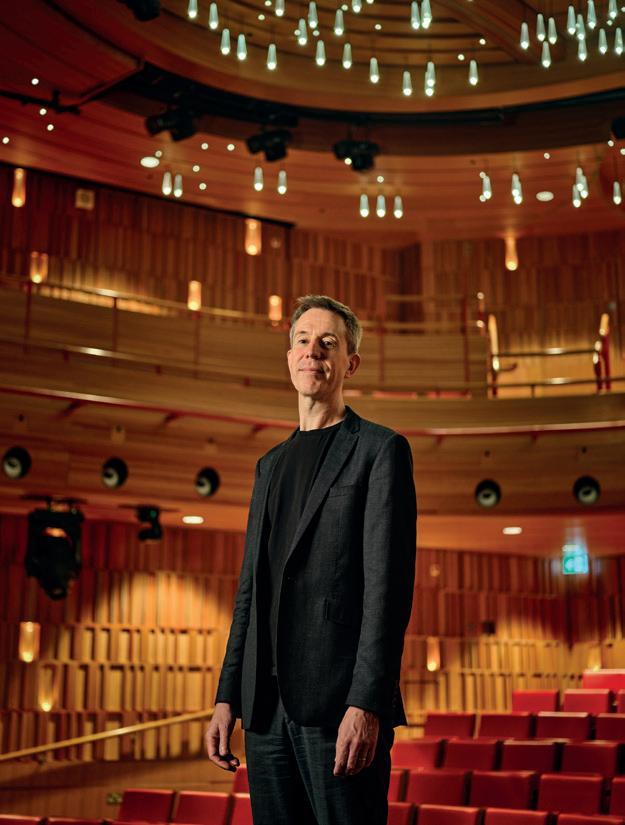
35 — MARYLEBONE JOURNAL / ISSUE NO. 100
THE DIFFERENCE MAKERS
“Music provides ways for people to connect, to communicate and share things. It builds a sense of community. It creates situations and contexts in which everyone can thrive.”
Workspace like no other
x+why bring Grade A flexible office space to 1 Great Cumberland Place - London’s most impressive space for businesses to connect, collaborate, and grow.
• Stunning design and views across Hyde Park
• Prime location next to Marble Arch station
• In the heart of The Portman Estate’s business community
• Managed & enterprise offices
• Exclusive roof terrace and event space with its own facilities
• Biophilic design to enhance employee wellbeing
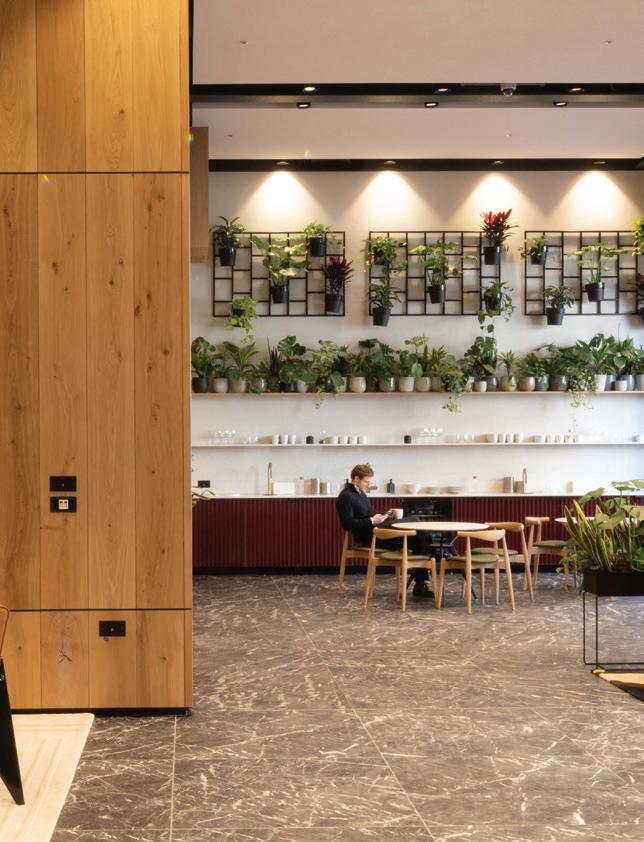
• BREEAM rated excellent
Plus, access to the Orchard, an exclusive hospitality focused members Clubspace, on the 8th floor. Enjoy impressive meeting rooms, and event space, a vibrant bar and food offering, private dining and terraces with unrivalled views across London
Available Summer 2023


Scan to find out more and book a tour
A CLOSER LOOK
FOOD » 38
STYLE » 44
HOME » 52
WELLBEING » 54
HEALTHCARE » 56
FOOD » 41
FOOD PHILOSOPHY
Cédric Badel of So French on starting a new life, working with traditional producers, and sharing a taste of his childhood
STYLE »44
Q&A
Freddie Elborne of sustainable eyewear brand MONC on the joy of specs and how his Chiltern Street store is looking to the future
HOME » 52
ANATOMY OF A DESIGN
Mark Winstanley of The White Company on a line of bed linen that reflects the company’s commitment to a good night’s sleep
Q&A: VICTOR LUGGER
The co-founder and CEO of Big Mamma Group, which runs wildly popular Italian restaurants in France, Germany and London, on its latest outpost: the typically spectacular Carlotta
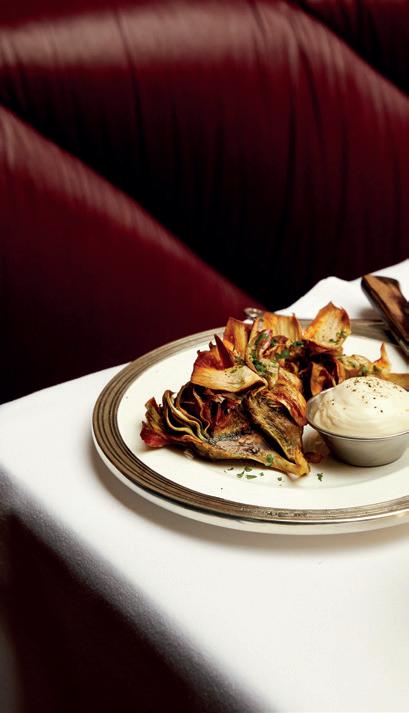
Interview: Clare Finney
Images: Sam Harris, Jerome Galland
38 — MARYLEBONE JOURNAL / ISSUE NO. 100
A CLOSER LOOK FOOD
You were born in France, studied business and founded a crowdfunding start-up before moving into restaurants. What inspired you to change course so dramatically? And as a Frenchman, why Italian restaurants? All families have their love language, and in my family it’s food. It has always been like this – with my parents, grandparents and greatgrandparents. It’s not about cooking incredibly well, necessarily – it’s about caring. One of the recent chats on our family WhatsApp was about what we’re cooking next Christmas! And that is not unusual for us. So that is how I became a restaurateur. As for Italy – well, if you want to be in the hospitality business for the long haul, and be successful, then you have to work incredibly hard. And to work hard, you have to do something you’re passionate about. We are not Italian; I grew up near Strasbourg and my dad is half German – but he often worked in Italy and I have spoken Italian from a young age. Opening Italian restaurants was an incredible opportunity to explore the Italian way of life, which I love for its conviviality, hospitality, and the way its culture, history, regionality and values are expressed through food. I could talk for ages about what is loveable about the Italian way of life, but I think most people know instinctively what I mean.
Were you not concerned about competition, given the sheer number of Italian restaurants that already exist in Paris and London?
I don’t look at other restauranteurs as competition, and I think you’d struggle to find many restauranteurs who do. We started 10 years ago, and we’ve met so many restauranteurs since then. They’ve become friends, they’ve become partners, and they’ve shared everything they can: from suppliers to knowledge of recruitment and buildings. Secondly, there were things we wanted to cook that we couldn’t find anywhere else. We had our story and we wanted to share the emotions that Italy creates within us.
What is that story, and how does that translate to the food?

I think it’s the story of simple, traditional food in an opulent atmosphere. We take sourcing seriously, and we never Anglicise or Frenchify our cooking, which isn’t easy – but at the same time the service, atmosphere and design creates fun and lightness. It’s about taking food very seriously, as Italians do, and taking everything else very lightly. Our food is not about the recipes, necessarily. You will find those online, and in books. What makes it taste the way it does is the producers who cure the parmesan and the ham, the farmers who supply the milk for the mozzarella, the chef who cares that the pasta is fresh enough, the pizzaiola who perfects the pizza in the last two minutes. It’s about creating a team and a workplace where chefs can express passion for food every single day, and who are happy to be here –because if they aren’t, the food won’t taste good, regardless of the recipe.
Big Mamma is a certified B Corp, one of very few restaurant groups to have achieved that status. What inspired you to go on that journey? We’ve been a B Corp for four years now, and you’re maybe only the fourth person to speak about it, which is interesting. I didn’t do it for people to ask me about it, obviously – but B Corp is something I think we could all be more aware of. It is a rating system that gives you points and makes something vague like ‘doing better’ very actionable, every day. It’s not just for me as a CEO, so I can brag about it at dinner parties; it’s for everyone: head office staff, waiters, chefs, the people touring suppliers in Italy. All of them have two or three responsibilities through which they participate in being a B Corp and help us do things a little bit better. I don’t think we’re going to save the world with pizza. But if we do things 0.1 per cent better every day, that compounds, and B Corp status fuels and informs our aspirations to make the world a better place.
39 — MARYLEBONE JOURNAL / ISSUE NO. 100 A CLOSER LOOK FOOD >
How is that reflected in your sourcing and your approach to running the business?
A friend of mine once told me that being an entrepreneur is making 20 decisions every day on matters you have no clue about. Having values helps, because it helps you narrow your choices and B Corp helps in the same way. The values don’t come from the sky; they are an aspiration to make the world a better place, distilled into a load of constraints and choices which help you make snap decisions on a daily basis on what to source and what not to source, and energy and buildings, and going totally
paperless. The other day we were having a conversation about a scallop dish I love in Jacuzzi, our restaurant in Kensington. It’s not on the menu anymore, and I was asking why. They said, well it’s not so responsible to source scallops after 15th May –and that was the end of that.
Big Mamma is famed for being opulent and overstated. How have you adapted the Big Mamma vibe to Marylebone, which is a fairly understated place?

When I moved to London five years ago, we were very tempted to live in Marylebone, because it seemed like
a nice transition from Paris. Then we ended up in Hampstead, which is as English a place as you can get. I love this neighbourhood, though – maybe because I am French, but also because it is beautiful, elegant, refined and rich in culture and heritage. It is understated, but the streets are vibrant. It could be a street in a city in Italy, with its rich mix of restaurants and retail. The way we’ve adapted is to create a restaurant that is a little more intimate, a little more elegant, a little more understated in many respects. The food is a homage to the Italian American culture. Most of our team and chefs are originally from the region that stetches from Rome to Puglia and Sicily, so we have revisited those recipes from mothers and grandmothers and added an Italian American touch – give it a sense of glamour and ‘je ne sais quois’ that makes everyone excited.
What has the space been like to work with?
What I like about this space is that when you enter into it, it feels big but at the same time full of little pockets and corners. I love that combination of intimacy and scale. Carlotta is a big restaurant and a small restaurant at
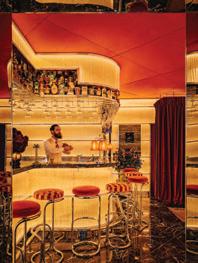
40 — MARYLEBONE JOURNAL / ISSUE NO. 100
A CLOSER LOOK FOOD
Victor Lugger (right) with Big Mamma co-founder Tigrane Seydoux
Right: The bar at Carlotta Opposite: The basement dining room
FOOD PHILOSOPHY
SO FRENCH
Cédric Badel, founder of the So French cafe and épicerie, on starting a new life, working with traditional producers, and sharing a taste of his childhood
Interview: Ellie Costigan
the same time. There’s the bar and the basement and the crazy toilets, and all those big-restaurant vibes – but then you are seated in a small nook with your loved ones. It echoes our first restaurant in Paris, East Mamma, and our first restaurant in London, Gloria, and those have a very dear place in my heart. I remember first visiting the old Natural Kitchen space and having that same feeling.
What restaurants in Marylebone do you most admire?
I think the food at Locanda Locatelli is very good, very Italian – and of course you can’t talk about

The concept of an épicerie is very French. It’s not like a supermarket: it is a different kind of product. Everything is artisanal and made in the oldfashioned way using traditional processes and know-how.
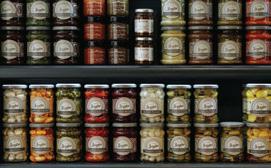
We sell what I like. If I don’t like something, I cannot sell it. I cannot talk about it. Some things that we sell, I used to eat as a kid – the biscuits I would have after school with my grandpa, for example. It is very personal.
Marylebone without talking about Chiltern Firehouse, which has done something very interesting in terms of design and atmosphere. At Fischer’s, Jeremy King created a beautiful space with a real vibe. I really respect these restaurants; I love them, in fact. I think what makes a great restaurant great is hard to say, but I would like to create a restaurant in which my guests will feel the same level of love and hospitality they feel now in 20 years’ time.
CARLOTTA
77-78 Marylebone High Street, London W1U 5JX bigmammagroup.com
So French is my third life. When I finished school I became an architect, and then later I worked in the fashion industry for 25 years. But I was born in Lyon, the capital of French gastronomy, so food was always important to me. I was bored of the fashion world and wanted to do something completely different: to go to another country, with a new language and start from scratch. So that is what I did.
There was a big difference in culture for me, coming from France. Here, everyone is on the go. In France, people take a bit more time to enjoy breakfast and lunch. With So French, I wanted to create a place where people could sit and enjoy a coffee before going to work, or on the way back from the school run. Somewhere to meet friends. It’s very French.
I have visited all of my suppliers. We keep a very close relationship. They are all people who enjoy life and enjoy food. They are all little companies and it’s a very small world. I will meet someone and they will introduce me to other producers they know. It might be the first time they have sold their products outside of France, so it’s a great opportunity for them.
Before I came to the UK, I used to escape Paris by coming to London on the weekends, because it was super easy and exotic for me. Another language, another culture, everything was different. I saw that even though the French community was huge and there were a lot of French restaurants, there weren’t really French épiceries. That’s when I started thinking about the concept of So French. It became my goal and nothing would stop me.
Every morning we get a delivery of fresh cakes from a French baker. We have baguettes and all the iconic French desserts such as eclair, then little individual tarts: pear, almond, lemon, cherry, apple. It is important to me that they’re authentic and the main thing for that is the ingredients. French butter, French flour. It changes the taste completely. Without them it can be good, but not real.
I tried the coffee many times when I came to London and I was not happy. When I opened So French, I met a Swedish couple who have a roastery in Surrey and asked them if they would be happy to create a blend just for So French. After many tries, we found the perfect balance – not weak, not too strong, not bitter. It’s what I like, I could have plenty!
We realised after a few weeks of being open that here the tradition is to have eggs for breakfast, which is not the case in France. We wanted to adapt to please everybody, but again keeping the French way. So we started to do French omelettes and now it’s one of the biggest successes.
The French community is important, but we have customers from everywhere –Americans, Italian, Japanese, Asian, Middle Eastern. It’s that mix that made me fall in love with London. It always makes me smile when I see our customers, who are all so different, coming here for the same reason. Everybody likes everybody, and that makes me so happy.
SO FRENCH
21 Seymour Place, W1H 5BH sofrench.co.uk
41 — MARYLEBONE JOURNAL / ISSUE NO. 100
A CLOSER LOOK FOOD
ULI
After opening in its original home on All Saints Road in 1997, Michael Lim’s ULI restaurant established itself as a firm favourite of critics and regular diners, with a pan-Asian menu reflecting the chef’s Singaporean roots and extensive travels. One of those besotted regulars, Graham Rebak, was absolutely horrified in 2013 to find his favourite restaurant had closed and its chef had retired. Graham, himself a restaurateur, tracked down Michael, talked him out of retirement, and joined forces with him to reopen ULI at a new home on Ladbroke Grove five years later. From an absence of ULIs, we now have an abundance, with a second branch set to open on Seymour Place with a similarly stylish setting and clean, healthy, inventive and flavour-packed menu.
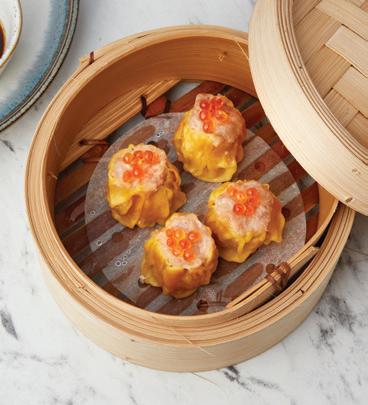
ULI
15 Seymour Place, W1H 5BE w1.ulilondon.com
A GLASS APART
Francesco Lombardi, director of food and beverages at The Prince Akatori hotel, on a Japanese single malt that changed the world of whisky
Interview: Viel Richardson
This year is the 100th anniversary of the Yamazaki distillery being founded in Shimamoto, in Japan’s Osaka Prefecture. One of its whiskies –the 18-year-old single malt –is close to my heart in both flavour and philosophy.

I first came across it quite a few years ago when I was working in a bar that decided to specialise in Japanese whiskies, which very few places in Europe were doing at the time. It was seen as something strange and new. Back then, there was an unease with the concept of Japanese whisky – it was all about whisky and bourbon, Scotland and America.
My first impressions were very surprising. My mind and palate were expecting one thing, but the whisky delivered something completely different. I was looking for certain familiar flavours and textures to come one after another, but that didn’t happen. At first, I couldn’t find the flavour notes I was looking for. But then I realised that they were there after all but were so beautifully balanced that none of them stood out.
The thing about Japanese whisky is that it’s made for the Japanese palate. What they were aiming for was something more rounded, softer,
42 — MARYLEBONE JOURNAL / ISSUE NO. 100 A CLOSER LOOK FOOD NEW ARRIVAL NEW ARRIVAL
NEW
easier to drink than a lot of scotch or bourbon. There are the malt notes, there are notes of apricots and raisins, with a bit of dark chocolate there as well. There is this soft sweetness, like crème brulée. Underlying it all is mizunara – a variety of Japanese oak – which is very subtle but stays with you throughout. It then ends with spice notes. This a complex whisky, but the key to it is that incredible balance. You never get one taste dominating the rest. This was a drink that changed the world of whisky, a drink that showed how high the bar could be set in other parts of the world. There has been greater commercial success for other makers, but for me Yamazaki is the most poetic of Japanese whiskies. It represents the desire to express Japanese culture through a traditionally western drink. It gives the world something that is a pure expression of Japan while still respecting the drink’s Scottish heritage. The world of whisky is a better place because of Japanese whisky and Yamazaki 18 has played a vital part in that. It is a truly wonderful drink.
THE MALT LOUNGE & BAR
50 Great Cumberland Place, W1H 7FD
theprinceakatokilondon.com
PRAWN SCOTCH EGG
Ravinder Bhogal, chef-owner of Jikoni, on one of the restaurant’s signature dishes
In a nutshell
The prawn toast scotch egg is the bonny love child of a British scotch egg and a Chinese prawn toast: quail’s eggs, coddled in a lovely, juicy prawn toast mixture, then coated with a mixture of breadcrumbs and prawn crackers before being deep fried. It’s served with banana ketchup and pickled cucumber: the perfect accompaniment.
The inspiration
I’ve always loved scotch eggs. They are such a fun and playful food and have always inspired me. I wanted to create something delicious, but also playful and different. Before I opened Jikoni I did loads of pop-ups, and I always put them on the menu. People went nuts over them, so I knew they’d have to be on the menu if I opened a restaurant. As for the banana ketchup, that came about because I had too many ripe bananas one day and I didn’t want a banana cake. I knew
you could do savoury things with fruit – many cultures use fruit in chutneys and pickles. It turned out that the banana ketchup and scotch egg married well together.
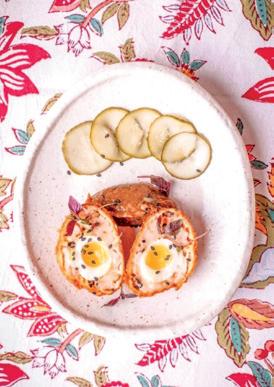
The purpose
I think the prawn toast scotch egg is really emblematic of what Jikoni is about, which is crossing borders and bringing culinary traditions together; making the political statement that when cultures come together and share, they end up creating something greater than the sum of their parts.
The technique
The quail’s eggs are boiled for two and a half minutes exactly, then plunged into ice-cold water to stop the cooking process. We find putting them in a solution of vinegar and water helps break down the shell, so they’re easier to peel when they’ve cooled down. The cooled, peeled eggs
are wrapped in the prawn toast mixture, which is prawns blitzed with fresh ginger, soy sauce and spring onion (the green parts in particular have so much flavour). Then they’re twice rolled in flour, egg and a mixture of panko breadcrumbs and Thai prawn crackers so that when you deep fry them they puff up and go very crispy. The pickled cucumber is deep fried as well, providing a clean fatty pickle to cut through it all.
The secret
The real secret is the double crumbing, so there are two layers of crisp coating, and using the Thai prawn crackers in with the breadcrumbs. That is quite unique, lending another layer of flavour as well as a crunch.
JIKONI
19-21 Blandford Street, W1U 3DH jikonilondon.com
43 — MARYLEBONE JOURNAL / ISSUE NO. 100
A DISH
ANATOMY OF
A CLOSER LOOK FOOD

44 — MARYLEBONE JOURNAL / ISSUE NO. 100 A CLOSER LOOK STYLE
Q&A: FREDDIE ELBORNE
The founder of sustainable eyewear brand MONC on the joy of specs and how his Chiltern Street store is looking to the future
Interview: Lauren Bravo
the obvious answer. The 10-person company we use is one of the last few family-run ateliers, up in the Dolomites. I go there a lot and it completely recharges my passion for the product.
plant-based, making the material about 75 per cent bio-sourced. If there’s a waste stream we have no control over, then we should at least be using a material that’s made more from plants than petroleum.
Glasses aren’t just for geeks. But do you have to be a nerd to make the best specs?
I’ve been obsessed with eyewear for a long time. When I was growing up my dad had an old pair of Persols – the iconic sunglasses brand – and I was so jealous when my oldest brother ‘inherited’ (stole) them. I saved up and bought my own pair when I was 18, and discovered that buying a truly iconic design piece like that makes you feel a certain way. Then I went and studied product design and engineering at uni and realised that I’m a very physical creative. Being in a factory is my first love; watching people making stuff, developing great products and seeing them being used. That’s what makes me tick.
Why is ‘made in Italy’ such a badge of pride for MONC?
Italy has the eyewear heritage. The very first pair of eyeglasses was actually made there, way back in the 13th century, and Italians invented all the methods of production that we still use today. Over the centuries they’ve become the best in the world. When I started out I wanted somewhere I could visit easily and regulate what was going on, somewhere that I knew would craft a quality product, so Italy was
Most of us only have a few pairs of sunnies, compared to wardrobes filled with clothes – so what makes glasses unsustainable? The focus has been on clothing as the big polluter for a while now, and footwear has come under the spotlight too, but eyewear has never really had that moment. Yet out of eight billion people in the world, about 75 per cent require vision correction, and 60 per cent use sunglasses or UV protection – so that’s a lot of glasses, especially if you have a few different pairs. But it wasn’t until I visited a new manufacturer in 2018 that I discovered the extent of that impact. Out behind the workshop were piles and piles of what looked like multicoloured hay. They explained it was the waste that comes from their glasses production: the scraps left when you cut the frames out of a sheet of acetate. The company had to pay to get it taken away and incinerated or sent to landfill. It really opened my eyes and made me determined to make our products differently.
Enter your beloved bio-acetate. Is it guilt-free plastic by another name? Acetate itself has been used for about 80 years in eyewear and other products such as hairclips and pens. It’s not technically a plastic, but it’s plastic-like. It’s actually made from a combination of plant fibres, often cotton, processed with acetone and petroleum-derivatives to make a clear, flexible, mouldable material. But traditional acetate, which makes up a massive percentage of frame production as a whole, is only about 45 per cent bio-sourced material. As soon as I had that eye-opening experience, I said “we have to use something better”. Bio-acetate was developed in the early 2000s by swapping some of the plasticisers to
So MONCs will biodegrade… but not while we’re wearing them, right? No. Bio-acetate is biodegradable according to ISO and REACH regulations, and if left in a natural environment it will break down over a much shorter period of time than traditional plastics, which is brilliant. But we’re careful about that language, because we don’t want consumers to think ‘I can just chuck this in the compost heap’ or ‘if this goes in the ocean, it’ll dissolve’, because that isn’t the case. We’d rather you bring your glasses back to us instead. We’re working on a localised recycling solution in Italy, which will enable us to produce a bioacetate that’s made from 95 per cent recycled material. Although to be fair, in six years we’ve only had about 20 people need to recycle our frames. They don’t break very often.
So that’s why we should be investing in sunglasses, rather than plucking another ‘emergency’ pair off a market stall?
A lot of people buy cheaper sunglasses because they believe that they’re going to lose them; they’re almost a disposable product. But the problem is that those sunglasses are manufactured without any sustainable vision at all – they’re designed to break. So we try to convince people to invest more in them. If you invest in a pair of glasses or sunglasses that are designed well, they can be maintained, and that was our goal: to build a product that is repairable and replenishable and that you’re able to take care of, so it’ll last a long time. It’s pretty simple really.
Your frames are named after the world’s great creative districts –Kreuzberg, Nørrebro, Kallio. But what brought you to Marylebone?
45 — MARYLEBONE JOURNAL / ISSUE NO. 100
A CLOSER LOOK STYLE >
We wanted to find somewhere with a selection of brands that resonate with us – and to tell the truth, we also wanted to find a place where there weren’t 10 other eyewear brands on the street. But Marylebone offers such a close-knit community, especially after Covid. There’s a special energy that you don’t get in many London neighbourhoods. We started as a one-year pop-up in 2021 – but we’re still here and we’re seeing it get better and better, especially on Chiltern Street. It’s our home now.
And there’s even a pair of Chiltern shades…

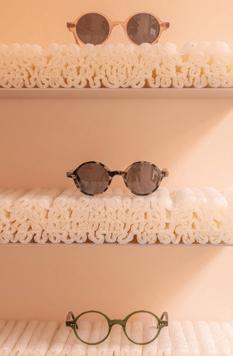
It was our first new design after we opened. We wanted them to be bold, unique and expressive, to sum up that special feeling you have when you set foot on this street. It’s really not like anywhere else.
Nor is this shop. How does your retail space reflect MONC’s vision? Even in a world where everything is going online, sunglasses and specs are still mostly bought in-store. So I knew that a physical space was the thing I had to do, but I wanted to do everything in a circular way. Our thought process was: we’re emerging from a pandemic, we don’t know if we’re going to go back into lockdown, we can’t commit to anything longterm – so let’s design in such a way that if we were to close in one month, or 12 months, we could leave virtually no trace behind. That led us to be really strict about the materials we were using. I hired designer Nina Woodcroft and together we came up with shelves and art made from dissolvable cornstarch, curtains made from hemp…
And a window display made from mushrooms?
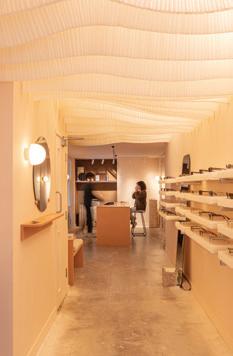
All of our display pillars look like Roman columns, but they’re actually made from mycelium, which is the thread-like structure of a fungus. It’s one of the most sustainable resources in the world, and it will biodegrade completely with zero impact – in fact
KJ’S LAUNDRY
Kate Allden, co-founder of KJ’s Laundry, on timeless design, working the shop floor and watching small brands flourish
Interview: Ellie Costigan
We’re always looking for something a bit under the radar. When we started out, women’s fashion was more overtly girly, and we wanted something that was a bit more us. We wanted to see smaller brands and at the time, there wasn’t much of that in London. We started by going to other countries – the States, Paris, and Italy at the beginning – and found some showrooms for smaller labels, met designers, and it grew from there.
Our own-label pieces are now some of our bestsellers. We design them ourselves: simple shapes with nice detailing, so
46 — MARYLEBONE JOURNAL / ISSUE NO. 100
A CLOSER LOOK STYLE
STYLE PHILOSOPHY
it will nourish the earth when it’s gone. That sums up the MONC ethos; we want to approach everything we do in a way that’s considered for quality and circularity. It’s about taking that responsibility from the start.
Speaking of big responsibilities, how do you help customers choose their new face furniture?
It’s a high-stakes purchase; your glasses are your personality, it’s what people see first when they look at your face. So when someone comes in asking for help, we take a look at how they dress, we get an idea
of their character and ask them a few questions that will lead them to the right pair. But every journey is unique. What we can do in our store is take the time to really consult with each customer, get to know them and help them get to know the designs. We’re trying to create an atelier experience, to give people confidence and make them feel comfortable letting us take care of their glasses way into the future.
Which famous eyes would you most love to frame?
You see Harry Styles quite a lot around these streets. He’d be a great
person to get in a pair of our glasses – he’s a style icon but also has such a grounded personality. But I think there’s been a resurgence in glasses being cool again thanks to stars like Jeff Goldblum. Generations who were bullied at school for wearing glasses are now reclaiming them as a statement of their identity. We have customers coming in who don’t even need vision correction, but just want to wear them for fashion’s sake. It’s like jewellery for the face.
MONC 21 Chiltern Street, W1U 7PH monclondon.com
how they’ve evolved. We’ve also been stocking Masscob for a very long time. They make understated, beautiful pieces –perfect for us. Classic, but with interesting elements.
Our tastes have changed a bit as we’ve got older. We’re even more considered than we were and probably a bit less frivolous, we take fewer risks, we really understand what our customers like to wear.
Jane and I try to be on the shop floor as much as we can – we both really enjoy it. The shop’s got a really nice vibe about it. We’ve got customers who’ve been coming in for years, so often it turns into a friendly chatting session. We put the world to rights! It’s a really nice environment to work in.
perhaps a little bit of pintucking, a lace insert or tiny ruffle, in an easy-wearing colour palette or print. Our Serena top is particularly popular: we keep doing it in different colours and prints and it just keeps selling. We’ve had a great response.


We like clothes we know we can get out year after year: we’re not completely driven by trends. When we come across a new print or silhouette, we might be interested, but we mostly prefer something more classic – something that, even if you put it to one side for a couple of years, you’ll come back to time and again. Things that are
long lasting, well made, quality fabrics. That’s what we’re about.
The women who shop in our store tend to be interested in fashion, but not driven by it. They also know their own minds – they don’t need anyone to tell them what to wear. They know which labels we sell and what they’re coming in for. We’ll never preach, we’ll just guide them around the store.
We love it when customers tell us about a dress or a top they bought from us years ago, that they still love and are still wearing. That’s what KJ’s is about: finding clothes that are
going to work in your wardrobe and that you’ll stay in love with.
We’ve been in Marylebone for 17 years now and it’s still an exceptional place. People actually know each other, which is so unlike other areas of central London.
Some of the labels we stock were very small to start with but have grown considerably over the years – and only gotten better. Xirena, for example, was tiny to begin with – they only had about six shapes when we first stocked them and now they’re massive. But we still love them and everything they do, we love
We are selective about what we bring in, so it’s really exciting finding new brands that we know will sell. This season, we got a new label in called Arifah Studio. Syarifah is a woman working in fashion who’s just created a little, artisan-led collection. We know the designer well and we know that she really embodies our customer. It’s really fun to find those labels, give them a chance and watch them grow – because they will.
KJ’S LAUNDRY
74 Marylebone Lane, W1U 2PW kjslaundry.com
47 — MARYLEBONE JOURNAL / ISSUE NO. 100
A CLOSER LOOK STYLE
Fleur top from Ulla Johnson
Honor shirt from KJ’s Laundry’s own label
SUNNY DISPOSITION






THE EDIT
LIFE CYCLE
agnès b, the legendary French designer, on a look from her new collaboration with Café du Cycliste

I have always loved cycling. I must have been one of the first to commute by bike in Paris. I used to get from my home on Rue de Rivoli to the office on Rue Dieu in nine minutes. There’s a photo of me on my bike at Place de la Concorde from 1994. I got to know Café du Cycliste through their café and workshop in the

48 — MARYLEBONE JOURNAL / ISSUE NO. 100 THE LOOK
A CLOSER LOOK STYLE
CLARA WIDE BRIM STRAW HAT TOAST, £69 toa.st
OVERSIZED BOY BLAZER THEORY, 410 uk.theory.com
SOPHIE TOP ISABEL MANNS, £350 isabelmanns.com
SHORT PRINTED GREEN DRESS KOOPLES, £ 260 thekooples.com
CORDA DIAMOND NECKLACE SET MONICA VINADER, £350 monicavinader.com
COLIN SUNGLASSES ACE & TATE, £110 aceandtate.com
CONDESA PINK SABAH, £185 uk.sabah.am
port in Nice, just where the ferries leave for Corsica. They then came to see me in my studio in Paris, and we hit it off straight away. Ours was a very natural and enthusiastic collaboration.
The inspiration behind the collection is movement, elasticity. “Voir plus loin” – to see beyond – is a
phrase I love! I really enjoy taking abstract photos, and I thought this one represented the idea of movement very well.
These clothes aren’t just for cycling, though – they can be worn for lots of different occasions. I can totally see myself wearing this look: I love the zipup jacket with the black
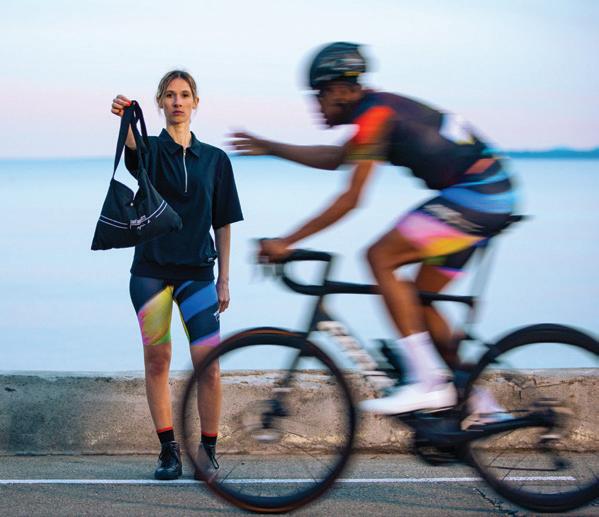
shorts, and I’d also add high socks for style. I like a silhouette with a little design. The short-sleeved jacket is really cute for summer, you can wear it with different things, like a skirt. It mixes well!
I don’t really like fashion, I only like real clothes; clothes that are fit for purpose, that don’t
take up too much space and that give real pleasure. That’s what I’ve always tried to do, particularly with work clothes, overalls, jackets and so on. This collection is part of that philosophy.
AGNÈS B
41-42 Marylebone High Street, W1U 4QH agnesb.co.uk
49 — MARYLEBONE JOURNAL / ISSUE NO. 100 A CLOSER LOOK STYLE
SWIMSUITS
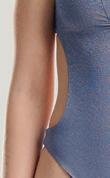
Britain’s a funny place. We spend half the year in semi-darkness; a quarter in light that’s cold but constant; and a quarter – at best – in sunshine. Nevertheless, we love bikinis, the most unforgiving of all clothing, leaving no rolls or moles or milkwhite underbellies unturned in their quest to expose everything under the burning sun. It doesn’t have to be this way. Swimming costumes are no longer just for school kids. They’re colourful, flattering and, in some instances, even raunchy. Unlike bikinis, these have your tummy and your back.

50 — MARYLEBONE JOURNAL / ISSUE NO. 100 A CLOSER LOOK STYLE
THREE OF THE BEST
1.
3. 2.

The Marylebone Journal can accept no responsibility for the tan lines that result from this edgy swimsuit – but we will take credit for any compliments incurred by its braided straps and metallic sheen. This is a costume to party in as well as paddle – and with a hardware back closure, is sturdier than you might expect when it comes to swimming.

All the comfort, support and belly-masking modesty of a traditional one-piece, but without the usual downside: the pasty white strapmarks that ascend your otherwise sun-kissed shoulders. Made in Italy using a seamless 3D knitting process, its body-hugging design promises to keep everything nicely in place, while exposing your clavicles to those golden rays.
Sézane
In an ideal world, swimsuits are for life, not just for summer. Sweaty Betty’s Tidal Xtra Life swimsuit doesn’t guarantee life, as such, but it does promise to hold its shape five times longer than elastane. The material is also formulated to be resistant to damage from chlorine, sun cream and UV50+ rays. It comes in a range of colours and styles, though it’s this blue lemon tree print that we’re eyeing.

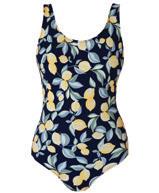
Morgane Sézalory – a designer and entrepreneur who radiates pure Parisian style – started her fashion career with an online business selling repurposed vintage clothing. Her next venture, Sézane, founded in 2013, saw her apply her talent for design and sustainable practices to clothes that are inspired by vintage fashion but created from scratch. After launching online, the brand quickly achieved cult status before expanding into bricks and mortar stores and adding a menswear line, Octobre Editions. Now, freshly minted with hardwon B Corp sustainability certification, it is set to bring its highly coveted collections to a new Marylebone store – just its second UK boutique – which is opening on the high street later in the year.
SÉZANE
28-29 Marylebone High Street, W1U 4PL sezane.com/en
51 — MARYLEBONE JOURNAL / ISSUE NO. 100
1. HIGH SHINE METALLIC SWIMSUIT WOLFORD, £245 wolfordshop.co.uk
2. TIDAL XTRA LIFE SWIMSUIT SWEATY BETTY, £65 sweatybetty.com
A CLOSER LOOK STYLE
3. ENERGISED STRAPLESS ONE-PIECE PRISM, £80 prismlondon.com
NEW ARRIVAL NEW ARRIVAL
NEW
SANTORINI BED LINEN
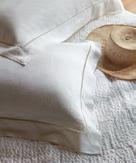
Mark Winstanley, chief creative officer of The White Company, on a line of bed linen that reflects the company’s deep commitment to a good night’s sleep
Interview: Viel Richardson
The requirement
At The White Company, we believe in the need to make your bedroom a sleep sanctuary. Somewhere that feels calm and serene. Our bedroom products are all guided by that simple principle. We are also led by the importance of sustainability, and have been for many years. We introduced the Santorini line 10 years ago, and sustainability was already central to our thoughts. The line is made from 100 per cent linen, which is produced naturally using the fibres of the flax plant. It’s grown free of genetically modified organisms and there’s no wastage of any part of the plant. Linen is primarily thought of as fabric that’s good during the hotter months of the year, but it’s also lovely to sleep under during the autumn and winter months, as it can give this wonderful sense of cosiness and warmth, perfect for that sense of sanctuary.
The inspiration
For the design details, we spent a lot of time looking at archives, exploring the ways in which hand-drawn thread work has
been produced for many decades, sometimes centuries. We then trialled a number of designs to see which we felt delivered the best results. Ultimately, we chose to use a ladder stitch, which is a style from way back when. It has that timeless quality, and it’s something the skilled artisans we work with have been producing all their lives.
The design aesthetic allows the Santorini linen to be used in any number of different ways, depending on the customer. It’s a bed linen that looks really fresh and contemporary, so can be styled in a clean, minimal, paredback way. Equally, because of this lovely stitch detail, it can be given a more vintage feel. If you want to create a calm, tranquil bedroom filled with whites and neutrals, you can do that. But if you want to use more colour and pattern, the white acts as a great foil. We wanted something that provided the perfect solution for whoever bought it.
The process
The linen is produced in villages in Vietnam, predominantly by women working in their own
homes. It is handmade using a process known as hand-drawn thread work or ‘jour’ (meaning ‘day’) work, a technique that is very much part of the Vietnamese handcraft heritage. These skills have been practiced for decades, with the knowledge being passed down through the generations. This particular hand-drawn ladder stitch has two phases. First, a number of parallel yarns are removed by hand from the base cloth. These are then wrapped and bound by hand across the remaining cross threads in the base cloth to create
the ladder pattern. As you can imagine, this takes a great deal of skill. The level of craftsmanship means that the material’s strength is not compromised by the open nature of the design. I still use pieces I bought when Santorini was launched a decade ago. This longevity is important to us. It means that a customer can expand or refresh their set with new pieces such as duvet covers, sheets or pillowcases for many years after that initial purchase.
The materials
We think that linen is a great choice for bedding, for several reasons. As well as keeping you comfortable through the seasons, it also has this loose, informal quality, which can work wonderfully well in a bedroom style. From a care point of view, some people don’t like linen because it creases easily, but others love it for the exact same reason. It brings a kind of ease and a sense of release. With the Santorini, the versatile characteristics of the linen mean you can choose which experience you have. Linen can be laundered and steamed so that it’s fresh

52 — MARYLEBONE JOURNAL / ISSUE NO. 100 A CLOSER LOOK HOME
ANATOMY OF
DESIGN
A
and crisp, or if line dried it can be left softly rumpled, giving you that relaxed hemp feel against your skin. It comes down to personal preference.

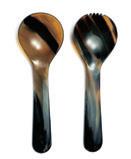
The philosophy
I think the stresses we all felt during the pandemic brought home to many people a realisation of just how fundamental to our physical and mental wellbeing good sleep is. At The White Company we’ve always believed in the bedroom as a sanctuary, it’s been our philosophy for the past 29 years. So much of what we do is based on our understanding of the importance of creating the right environment to promote good sleep. By using high-quality materials and design, we want to help people create the kind of environment that leads to them waking up each morning feeling relaxed, energised and wellrested. That’s what Santorini bed linen seeks to achieve.


THE WHITE COMPANY



112-114 Marylebone High Street, W1U 4SA thewhitecompany.com
OUTDOOR DINING
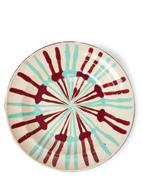
THE EDIT
53 — MARYLEBONE JOURNAL / ISSUE NO. 100 A CLOSER LOOK HOME
COLLAGERIE DRIP ROUND PLATTER THE CONRAN SHOP, £130 conranshop.co.uk
MARBLED ENAMEL MUG LABOUR AND WAIT, £12 labourandwait.co.uk
BENTO LUNCH SET TOAST, £39 toa.st
ABBEYHORN LARGE SALAD SERVERS DAVID MELLOR, £59 davidmellordesign.com
OUTDOOR JAAL BOX CUSHION DESIGNERS GUILD, £50 designersguild.com
YALI GLASS COCKTAIL STIRRER MOUKI MOU, £30 moukimou.com
NOTES ON A SANDLE
Margaret Dabbs on prepping your feet for summer
Interview: Ellie Costigan
One of the first feet challenges to be tackled after six months in socks is often hard, dry skin. What’s the best way of buffing them up?
The first step is to remove it with a foot file. For the best, most effective and longest lasting results always make sure you file your feet when they’re dry, before you bathe or shower– this is the biggest mistake people make, especially in beauty salons. It’ll leave your skin silkysmooth to touch.
After filing, don’t underestimate the benefit of using an exfoliating foot scrub. Do so once or twice a week, concentrating on your heels, between your toes and the balls of your feet. When you’re done scrubbing, wash it off, dry your feet and follow up with moisturiser –I like to use our intensive hydrating foot lotion.

What causes heels to crack and what can be done when they do?
Dehydrated, dry and hard skin can lead to cracks and fissures. These can be feather-like or quite deep, if you have particularly callous or hard skin. Removing hard skin in the way I’ve just described can really help to reduce and stop it from building up, as does moisturising daily.
What about things like athlete’s foot and ingrown toenails – how
can they be prevented and treated? Athlete’s foot is a fungal skin condition, often related to excessive sweating and wearing closed-in footwear for long periods of time. Bacterial and fungal infections thrive in these warm, moist conditions. Common symptoms are broken and scaly skin, especially between the toes, itching, blistering, sweaty feet, and sometimes odour. It can give you a burning, itchy sensation, or it can be pain-free and just unsightly. You can treat it at home with the daily use of foot hygiene cream before you go to bed. Using our soothing foot powder in the morning before you put on your socks will make your feet more comfortable, help with sweating and reduce itchiness, too. If you’re prone to athlete’s foot, it’s important you thoroughly dry your feet after bathing and showering, especially between the toes. Use a hairdryer on a warm or cool setting to ensure they’re completely dry. Ingrown toenails are usually the result of badly cut nails. It’s important to visit a foot health professional or podiatrist – especially if it’s ongoing. Otherwise, they can become infected, which is very painful.
How can we keep feet fresh in hot temperatures?

Excess sweating and odour can be an uncomfortable and embarrassing
issue for lots of people. The sweat glands are more concentrated in the feet than in any other part of the body, so it’s unsurprising that this can be problematic for some people. If you do suffer from sweaty feet, make sure you keep them clean and as dry as possible, with regular changes of socks and shoes. Our soothing foot powder will also help keep feet fit and healthy.
What’s your go-to care routine when you want to give your feet a real treat?
I start with the foot file, then use our exfoliating foot scrub before bathing my feet. As a treat, I like to use the Margaret Dabbs London pure foot soak, then finish with the intensive hydrating foot lotion. If you want an extra intensive treatment, add in the intensive treatment foot oil, which can be used both as a foot soak in water and also applied to the skin before the foot lotion. You’ll be amazed at the results!
What about when an at-home treatment doesn’t quite cut it? We offer a professional, medical pedicure, which can transform any feet. The treatment lasts 45 minutes and has been referred to as “life changing” – people often say that if they could only have one beauty treatment, this would be it. Once you’ve had it, you can maintain the results at home using our products.
Any other advice?
Feet always look groomed when the nails are neat – file the nails straight across to give the appearance of feet that have had a professional treatment.
MARGARET DABBS LONDON
7 New Cavendish Street, W1G 8UU margaretdabbs.co.uk
54 — MARYLEBONE JOURNAL / ISSUE NO. 100 A CLOSER LOOK WELLBEING
CRYSTAL NAIL FILE

MARGARET DABBS, £16
FOOT LOTION
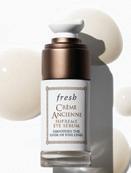




MARGARET DABBS, £14
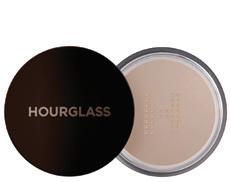
TRAVEL MINIS
THE EDIT
CRÈME ANCIENNE SUPREME EYE SERUM FRESH, £180 fresh.com
55 — MARYLEBONE JOURNAL / ISSUE NO. 100 A CLOSER LOOK WELLBEING
HOURGLASS VEIL TRANSLUCENT SETTING POWDER, TRAVEL SIZE SPACE NK, £21 spacenk.com
HAND POMADE LE LABO, £24 lelabofragrances.com
EAU DES SENS HAIR MIST DIPTYQUE, £55 diptyqueparis.com
DEODORANT AESOP, £25 aesop.com
ZAGARA BODY CREAM ORTIGIA, £16 ortigiasicilia.com
56 — MARYLEBONE JOURNAL / ISSUE NO. 100 A CLOSER LOOK HEALTHCARE
LASER QUEST
Mr Marios Hadjipavlou, consultant urological surgeon at King Edward VII’s Hospital, on HoLEP, a highly effective laser procedure for shrinking an enlarged prostate
Interview: Viel Richardson
Let’s start by clearing up the acronym. What does HoLEP stand for, and what does it mean?
HoLEP stands for holmium laser enucleation of the prostate. It is a minimally invasive procedure in which a specialised telescope is inserted through the urethra –the tube through which we urinate – up to the prostate gland. Using a laser, we then remove the inner part of the prostate to create a wider channel to help with urination. It is a procedure that has been performed for many years without becoming widely used, mainly due to a lengthy learning curve, but it is now picking up more momentum thanks to advances in laser technology and other equipment. These advances are allowing surgeons to remove the prostate tissue more quickly, more effectively and with fewer complications.
What are the symptoms of an enlarged prostate in men?
The typical symptoms that men experience are difficulty urinating and reduced urine flow, particularly in the mornings. They can also suffer from hesitancy, which is when you need to urinate but have difficulty starting. There is also double voiding – this is when you’ve been to the toilet and think you’ve finished, only to need to go again very soon afterwards. Finally, a common issue is having to get up in the night, often multiple times, to urinate.
What can happen if this is left untreated?
One thing to say is that some cases can be treated with medication or simple lifestyle changes, so it doesn’t always have to be surgery. There are several issues that can develop if the issue is not tackled. One is a risk of urinary retention. In fact, I would say that one in three men who I do this procedure on have gone into urinary retention. This is when the prostate has become so enlarged that they cannot urinate naturally at all and can only empty their bladder through a catheter into
a bag. Another risk is that of blood in the urine and an increased risk of infection. In extreme situations, urine can flow back into the kidneys if the bladder is not emptying properly, which can cause long-term kidney damage.
To make something clear, benign prostate enlargement, which we are talking about here, typically has some of these symptoms, while prostate cancer doesn’t until it is quite advanced. A regular prostate specific antigen (PSA) blood test and prostate examination is recommended to men over 50 years old but also to younger men who have a family history of prostate cancer.
What is the traditional way of treating this issue?
The traditional procedure for men with prostate enlargement who do not respond to or do not wish to take medication is a transurethral resection of the prostate (TURP), which is essentially coring the prostate to shrink it. This is still commonly performed for men with prostate enlargement. The main limitation of this procedure is that it is not suitable for prostates that have grown to over 70-80g. (For reference, a normal prostate is 3035g.) This is because some tissue will be left behind, and this tissue will regrow with time, meaning another operation may have to be performed in the future. The other disadvantage of TURP is that because we’re actually cutting through the prostate, there will usually be some bleeding and most patients will need a hospital stay of two nights, possibly more.
Are there any other potential complications with TURP?
As well as the risk of bleeding, there is a risk of infection in the area, so antibiotics are administered during the operation to reduce the chances of that happening. There is also a small risk of stricture, where the urethra is narrowed on the inside as a result of scarring from the operation. Another small risk is erectile >
57 — MARYLEBONE JOURNAL / ISSUE NO. 100 A CLOSER LOOK HEALTHCARE
dysfunction. Some men will find that their erections are not as good as they used to be and might need some medication to help. Finally, a rare complication is incontinence, which is leakage of urine.
One consequence of the procedure is retrograde ejaculation, which happens to most men who have a TURP and also occurs with HoLEP. This is when at climax no ejaculate comes out, and it instead flows back into the bladder. This is not harmful in any way whatsoever but someone wanting to have children should not have either procedure.
What are the major advantages of HoLEP?
One of the main advantages is that the risk of post-operative bleeding is much lower and this typically results in a shorter hospital stay. Another is that it can be performed regardless of the prostate size. We can do anything from a minimally enlarged prostate, measuring 40g to a hugely swollen prostate measuring 500g – there’s no upper limit. Prostates that large are pretty rare, but we do see them. Another advantage is the very low risk of re-intervention, as there is very little tissue left to regrow. The chance of needing another operation after the HoLEP procedure is 5 per cent or less.

Talk us through the procedure.
The HoLEP operation is performed under a general anaesthetic. A telescope with a laser attached at the tip is fed up through the urethra. The laser is used to carve out the prostate from its capsule from the inside. Once the prostate is detached, a device called a morcellator is used to break up the prostate tissue, which is then sucked out through the same telescope. This way we can reduce unwanted tissue damage to a minimum. The operation typically takes between one hour and 90 minutes, depending on prostate size. At the end of the operation, a catheter is inserted which typically stays there for one night after the procedure. Once we’re sure that the urine is clear,
we remove the catheter and as soon as the patient is able to pee without any problems, they can go home.
All surgical procedures have risks. What are the main ones associated with HoLEP?
Most patients will experience some minor blood in their urine intermittently for up to 10 days or so and this nearly always settles with time. The risk of infection is very low. There may be some temporary leakage of urine, but this gets better with time and some pelvic floor exercises. As I mentioned, nearly all patients will have retrograde ejaculation, but the risk of erection problems afterwards is less than 5 per cent.
What is the usual recovery pathway?
Because of its minimally invasive nature, patients recover extremely quickly. It’s usually a painless recovery and patients will typically not need any painkillers after the operation. There might be some discomfort when urinating for the first few days. There may be some blood in the urine, as well as increased urgency and frequency of urination, but these are not worrying signs and they will settle down with time and good hydration. Most people will go back to their usual domestic activities as soon as they go back home. For more strenuous activities, like running, jogging
and heavy lifting, it is best to give it a couple of weeks. But most people are back to normal within a month.
Are there any people who would not be suitable for that procedure? Not really. There are no specific contraindications for HoLEP.
Are there any improvements you would like to see in the procedure?
It’s a very exciting time to be a HoLEP surgeon because more powerful lasers have been introduced which allow for better homeostasis, which is control of bleeding. Also, we are now using devices such as the ‘piranha morcellator’ which dramatically reduces the time it takes to safely remove prostate tissue compared to older instruments. I think we’re heading in the right direction as these developments all reduce the impact on the body, leading to shorter stays in hospital and faster recovery times.
What is it you enjoy most about what you do?
With no doubt whatsoever, it is how pleased the patients are after the operation. Many of these people have struggled with urinary symptoms but been tolerating them for years. Something I hear often is: “I don’t know why I didn’t have it done sooner”, or “I don’t know why I thought that it was normal to take so long to pee or to have go to the toilet four times a night.” It gives you a sense of just how life-changing the procedure can be. I recently had a patient tell me that the procedure had given him a new lease of life – those were his exact words. Those are the moments you remember. Some men have been controlled by their condition for years. Their schedules, their journeys, their activities have all been based around the availability of nearby toilets. To have made such a life-changing improvement and to see their relief is certainly incredibly satisfying.
KING EDWARD VII’S HOSPITAL
5-10 Beaumont Street, W1G 6AA
kingedwardvii.co.uk
58 — MARYLEBONE JOURNAL / ISSUE NO. 100 A CLOSER LOOK HEALTHCARE
So we’ve created health check packages which include a consultation with an expert in your condition, a diagnostic test and a follow up plan for treatment.


So whether you are looking for pre-emptive checks for peace of mind or struggling to get off waiting lists for a diagnosis, you can start planning for the future.


King Edward VII’s Hospital we know that worrying about
health and
for a
can be
and
At
your
waiting
diagnosis
upsetting
frustrating.
£595 Rated Excellent on Doctify 4.83 out of 5 based on 2610 patient reviews
Health Checks from
discount* on diagnostics or treatment including
10%
your health check at King Edward VII’s Hospital, your consultant may recommend additional diagnostic tests, imaging, or treatment and if you decide to continue with your treatment at King Edward VII’s hospital you will be eligible for a 10% discount* on the self-pay charges. *T&Cs apply. Diagnostic tests, imaging and surgery must be booked within three months of the date of the first health check appointment. The discount applies to self-pay hospital fees only. Consultant and professional fees are not included in this offer. This offer cannot be added retrospectively. This offer cannot be used in conjunction with any other discount offer. Refer your patient Patient Consultation within 48 hours E-learning module Treatment & management Physiotherapy services Diagnostics Doctor Bowel habit GP Services Blood in stools Health & Fitness Screening Services Abdominal pain Musculoskeletal pathway 48 48 48 Find out more at kingedwardvii.co.uk or call our friendly team on 0203 991 1182 Book your health check and see a specialist within 48 hours: • Hip • Knee • Shoulder • Breast • Mole • Haemorrhoid • Hernia & Abdominal Pain
surgery.
Following
MY PERFECT DAY
For many years, food writer, author and Journal stalwart

Clare Finney has been interviewing people about their ideal Marylebone day for this popular column. For our 100th edition, she sets out on a perfect day of her own

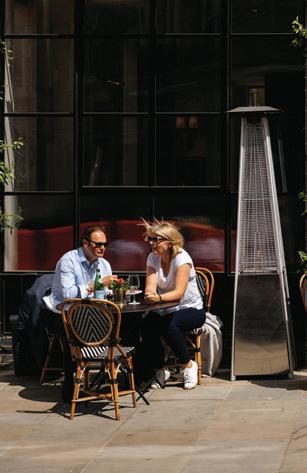
Breakfast
Porridge at Bonne Bouche. It’s the biggest, hottest Daddy Bear bowl of porridge in Marylebone. Every year my mum and I have it before going Christmas shopping, and it sees us right through to afternoon tea.
A breath of fresh air
I love an aspirational wander down Chiltern Street. I choose a wedding dress I can’t afford, a pair of specs I’d never suit, a
saxophone I can’t play and an arty magazine I won’t understand, all while taking in the peace and quiet of one of the most beautiful streets in London.
Coffee
Like most places in Marylebone the Chiltern Street Deli is somewhere you’ll go in for a coffee and come out with a pastry, posh pickles, a sandwich and some chargrilled artichokes. The only way to prevent expensive
60 — MARYLEBONE JOURNAL / ISSUE NO. 100 A CLOSER LOOK FOOD
108 Bar
Daunt Books
Lurra
browsing is by engaging with the baristas while they perfect your coffee order –which is easy, because they are excellent fun.

A new outfit
Cancer Research UK on the high street. Marylebone is a well-heeled area, and many of those wonderful heels (and dresses, and tops) end up in this beautifully curated charity shop. No, the outfit is not new new –but it’s new to me, and that’s what matters.
Shopping in general
Every year my dad (at my request) buys me the same perfume for my birthday. I’m not going to say what it is because I don’t want everyone to wear it, but it’s freshly made in front of us in this suitably lab-like Le Labo and bottled in the same bottle I’ve had since he first bought it for me, years ago.
Some culture
I love The Wallace Collection – it’s a haven of
stability and beauty in a turbulent and often ugly world, and the current collection of dog portraits is heart-melting. And Daunt Books of course. It’s iconic. Having my own book stocked there is genuinely one of the greatest highlights of my career.
Pre-dinner drinks
I will always have a soft spot for 108 Bar. It’s where my parents and I used to go for a mid-week wine
after work when we lived in Marylebone, and it’s where the Marylebone Christmas Lights and Summer Festival celebrations often end up. It’s a proper local, with a fair bit of glam – much like Marylebone itself.
Dinner out
Ironically, given how much time I spend eating out for a living, this is one of my least favourite questions. I hate being forced to choose between so many darlings! But if I’m pushed – Jikoni or Lurra; the former for its beautiful interiors and famed prawn scotch egg, the latter for its whole grilled turbot –a rustically luxurious joy.
Dinner in
La Petite Poissonnerie is as charming a place to buy seafood as its name suggests. It’s run by a French and Japanese couple, who hail from culinary cultures which really know and care for fish and make the whole experience of choosing, buying and cooking dinner a delight.
Anything else
In my family, afternoon tea is sacrosanct; not the three-tiered affair with scones and sandwiches and ‘fancy teas’, as my grandmother calls them, but a proper cuppa and a slice of homemade – or homemade-esque – cake at 4pm every day. No perfect Marylebone day would be complete without it, and we invariably return to Bonne Bouche for one of their nutty, fudgy shortcake numbers and a pot of strong tea.
61 — MARYLEBONE JOURNAL / ISSUE NO. 100 A CLOSER LOOK FOOD
George Street, Marylebone, W1H
Guide Price £3,495,000
A newly refurbished apartment, with its own private entrance in a secure 24-hour portered block.


A luxurious family apartment, beautifully refurbished and reconfigured, offering three to four bedrooms, each with an en-suite bath or shower room, builtin storage and air conditioning. The apartment is situated on the raised ground floor and benefits from two entrances: one through the main portered entrance, but also its own unique entrance as well, giving the new owners both privacy and security.


Leasehold: 100 years

If you are looking to buy or sell and would like advice on the current market or a free market appraisal contact:
Nicholas Jaffray
07515 777 634
Nicholas@Jaffray-Estates.co.uk
www.Jaffray-Estates.co.uk
42 Upper Berkeley Street London W1H 5QL
PORTMAN MANSIONS, CHILTERN STREET, MARYLEBONE W1
020 7486 6711
sales@mcglashans.co.uk
lettings@mcglashans.co.uk

£2,750,000 STC
A stunning 3 bedroom first floor apartment which has been refurbished in a contemporary style. Reception room with dining area / open plan kitchen, balcony, 3 bedrooms all with en suite bathrooms, guest cloakroom, lift, 24hr porters, EPC – C, Service charge – £8,773.82

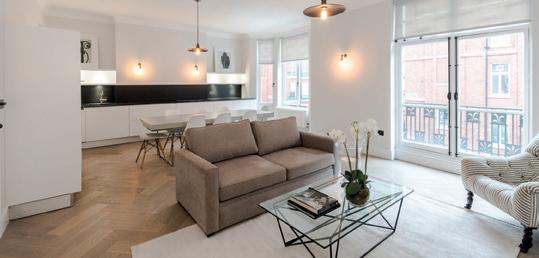
BLANDFORD STREET, MARYLEBONE W1
£2,500 PW / £10,833 PCM
A bright and spacious 5 bedroom family home. Living room with dining area, eat in kitchen, 5 bedrooms, 3 bathrooms, 2 private terraces, guest cloakroom, study, private garden. EPC – D, Council tax – Band H (Westminster), Security deposit – £15,000
BEVERSTON MEWS, MARYLEBONE W1
£1,350 PW / £5,850 PCM
A rare opportunity to rent this beautiful mews house. Living room, kitchen open plan to dining room, 2 double bedrooms, 2 bathrooms (1 en suite), private gated mews. EPC – D, Council tax – Band G (Westminster), Security deposit – £8,100

EXECUTIVE PROPERTY SPECIALISTS
107
WWW.MCGLASHANS.CO.UK For tenancy Info please refer to the website
CRAWFORD STREET, LONDON W1H 2JA
WEYMOUTH STREET, MARYLEBONE VILLAGE, LONDON W1G
A bright, newly refurbished two-bedroom apartment located on the third floor in the heart of Marylebone Village.
This recently refurbished two-bedroom apartment designed by award-winning architects Manalo & White benefits from comfort cooling. The kitchen includes Quooker taps allowing for filtered chilled and hot drinks.

The building is ideally located just a few minutes’ walk to Marylebone High Street with its fabulous restaurants, bars and high-end boutiques. Bond Street underground station is a short walk away with Regent’s Park also nearby.
£900 PER WEEK
WIMPOLE STREET, MARYLEBONE VILLAGE, LONDON W1G
We are delighted to bring to the market this delightful two-bedroom apartment in a stylish period conversion comprising of six apartments.
This unique apartment is approximately 1,283 sq ft (119.2 sq m) and comprises of two double bedrooms, one en-suite bathroom, reception room, kitchen, separate dining room, and second bathroom. With two terraces and a skylight in the reception room, it is exceptionally light and airy.

The building is close to the junction with New Cavendish Street, moments from the shops of Marylebone High Street. Bond Street and Oxford Circus stations and the open spaces of Regent’s Park are also nearby.
£1,525,000
AGENCY ESTABLISHED 1981 jeremyjames@jeremy-james.co.uk 020 7486 4111 www.@jeremy-james.co.uk MARYLEBONE PROPERTY AGENCY ESTABLISHED 1981 jeremyjames@jeremy-james.co.uk 020 7486 4111 www.@jeremy-james.co.uk
MARYLEBONE PROPERTY
Devonshire Close Marylebone W1G

2 bedrooms • 1 bathroom


Leasehold 39 years
Guide price: £900,000
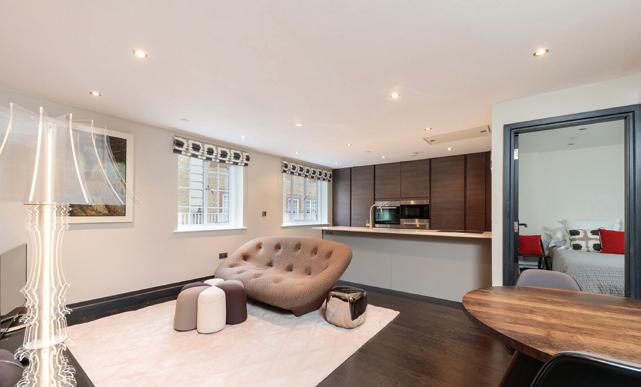
Marylebone
robert.oatley@carterjonas.co.uk
This beautifully refurbished two bedroom apartment is situated in a
tranquil
mews cul-de-sac within the heart of Marylebone Village.
•
•
Flat / apartment • Garage
& Regent’s Park 020 7299 2447

0203 982 3856 enquiries@clubfiftyone.co.uk 51 New Cavendish Street Intelligent fitness for body and mind. Join your gym tribe at clubfiftyone.co.uk

























































































































